The 24 Best eCommerce Retail Case Studies Worth Reading

In the fast-paced world of retail and eCommerce, staying ahead of the game is not just a goal; it’s the lifeline of our industry. For seasoned retail executives, inspiration often comes from the experiences and successes of industry giants who paved the way with their innovative thinking and managed to thrive through thick and thin. That’s why we’re excited to bring you an exclusive collection of the 30 best eCommerce case studies meticulously curated to provide you with a wealth of insights and ideas to fuel your strategies. These case studies are more than just success stories; they are beacons of guidance for retail professionals navigating the ever-changing landscape of our industry.
In this article, we delve deep into the journeys of retail giants who have not only weathered the storms of disruption but have emerged as trailblazers in eCommerce. From adapting to shifting consumer behaviors to mastering the art of online engagement, this compilation offers a treasure trove of wisdom for the modern retail executive.
Table of Contents
- > Case studies for grocery/wholesale eCommerce retailers
- > Case studies for fashion eCommerce retailers
- > Case Studies for home & furniture eCommerce retailers
- > Case Studies for health & beauty eCommerce retailers
- > Case studies for electronics and tools eCommerce retailers
- > Case Studies for toys and leisure eCommerce retailers

Case studies for grocery/wholesale eCommerce retailers
Retail case study #1: tesco .

Industry : Grocery stores
Why worth reading:
- Historical evolution: Understanding Tesco’s rise from a group of market stalls to a retail giant provides valuable lessons on growth and adaptation to market changes.
- Customer service focus: Tesco’s long-term emphasis on customer service, which is consistent across their physical and online platforms, showcases the importance of customer-centric strategies.
- Innovation in eCommerce: The case study covers Tesco’s pioneering of the world’s first virtual grocery store in South Korea, a testament to its innovative approach to digital retailing.
- Crisis management: Insights into how Tesco handled the Horse Meat Scandal, including efforts to tighten its supply chain, contributing to its logistical success.
- Financial integrity: The study discusses the Accounting Scandal, offering a sobering look at financial transparency and the repercussions of financial misreporting.
Read the full Tesco case study here .
Retail case study #2: Walmart

Industry : Discount department and grocery stores
- Data-driven success: The case study provides a wealth of data, showcasing Walmart’s remarkable achievements. With an annual revenue of almost $570 billion, a global presence in 24 countries, and a customer base exceeding 230 million weekly, it’s a testament to the effectiveness of their strategies.
- Marketing strategies: The case study delves deep into Walmart’s marketing strategies. It highlights their focus on catering to low to middle-class demographics, the introduction of the Walmart Rewards loyalty program, and their commitment to environmental sustainability, all of which have contributed to their success.
- eCommerce transformation: As eCommerce continues to reshape the retail landscape, this case study details how Walmart shifted significantly towards omnichannel retail. Readers can learn about their innovative technologies and approaches, such as personalized shopping experiences and augmented reality, that have helped them adapt to changing consumer behavior.
- Supply chain innovation: Walmart’s proficiency in supply chain management is a crucial takeaway for retail executives. Their decentralized distribution center model , in-house deliveries, and data-driven optimization exemplify the importance of efficient logistics in maintaining a competitive edge.
Read the full Walmart case study here .
Retail case study #3: Sainsbury’s

Industry : Grocery stores
- Omnichannel success amidst pandemic challenges: With the fastest growth in online shopping among major retailers, the study illustrates how Sainsbury’s adapted and thrived during unprecedented times.
- Dynamic brand positioning: The analysis delves into Sainsbury’s strategic shift in brand positioning, demonstrating a keen responsiveness to changing consumer preferences. This shift showcases the brand’s agility in aligning with contemporary health-conscious consumer trends, supported by relevant data and market insights.
- Supply chain and quality assurance: The study highlights Sainsbury’s commitment to a stellar supply chain, emphasizing the correlation between high product quality, ethical sourcing, and customer loyalty. With data-backed insights into the extensive distribution network and sourcing standards, retail executives can glean valuable lessons in maintaining a competitive edge through a robust supply chain.
- Innovative technological integration: Sainsbury’s implementation of cutting-edge technologies, such as Amazon’s “Just Walk Out” and Pay@Browse, demonstrates a commitment to providing customers with a seamless and convenient shopping experience.
- Diversification beyond grocery: The case study unveils Sainsbury’s strategic partnerships with companies like Amazon, Carluccio’s, Itsu, Leon, and Wasabi, showcasing the brand’s versatility beyond traditional grocery retail.
Read the full Sainsbury’s case study here .
Retail case study #4: Ocado

- From startup to industry leader: The Ocado case study presents a remarkable journey from a three-employee startup in 2000 to becoming the UK’s largest online grocery platform.
- Omnichannel excellence: The study emphasizes Ocado’s success in implementing an omnichannel approach, particularly its early adoption of smartphone technology for customer engagement.
- Operational efficiency: From automated warehouses with machine learning-driven robots to digital twins for simulating order selection and delivery processes, the data-rich content sheds light on how technology can be leveraged for operational efficiency.
- Navigating challenges through innovation: Ocado’s strategic response to challenges, particularly its shift from primarily a grocery delivery service to a technology-driven company, showcases the power of innovative thinking. The case study details how Ocado tackled complexities associated with grocery deliveries and embraced technology partnerships to stay ahead.
- Strategic partnerships: The study sheds light on Ocado’s strategic partnerships with grocery chains and companies like CitrusAd for advertising opportunities on its platform.
Read the full Ocado case study here .
Retail case study #5: Lidl

Industry : Discount supermarkets
- Longevity and evolution: The article provides a detailed overview of Lidl’s origins and evolution, offering insights into how the brand transformed from a local fruit wholesaler to a global retail powerhouse. Understanding this journey can inspire retail executives to explore innovative strategies in their own companies.
- Global success: Retail executives can draw lessons from Lidl’s international expansion strategy, identifying key factors that contributed to its success and applying similar principles to their global ventures.
- Awards and recognitions: The numerous awards and accomplishments earned by Lidl underscore the effectiveness of its marketing strategy. Marketers and eCommerce professionals can learn from Lidl’s approach to quality, innovation, and customer satisfaction.
- Comprehensive marketing components: The article breaks down Lidl’s marketing strategy into key components, such as pricing strategy, product diversification, and target audience focus. Readers can analyze these components and consider incorporating similar holistic approaches in their businesses to achieve well-rounded success.
- Omnichannel transformation: The discussion on Lidl’s transformation to an omnichannel strategy is particularly relevant in the current digital age. This information can guide executives in adopting and optimizing similar omnichannel strategies to enhance customer experiences and drive sales.
Read the full Lidl case study here .
Retail case study #6: ALDI

Industry : FMCG
- Omnichannel approach: Aldi’s growth is attributed to a robust omnichannel strategy that seamlessly integrates online and offline channels. The case study delves into how Aldi effectively implemented services that can overcome the intricacies of a successful omnichannel approach in today’s dynamic retail landscape.
- Target market positioning: Aldi’s strategic positioning as the most cost-effective retail store for the middle-income group is explored in detail. The case study elucidates how Aldi’s pricing strategy, emphasizing the lowest possible prices and no-frills discounts, resonates with a wide audience.
- Transparency: Aldi’s commitment to transparency in its supply chain is a distinctive feature discussed in the case study. For retail executives, understanding the importance of transparent supply chain practices and their impact on brand perception is crucial in building consumer trust.
- Differentiation: Aldi’s successful “Good Different” brand positioning, which communicates that low prices result from conscientious business practices, is a key focus of the case study. Effective differentiation through brand messaging contributes to customer trust and loyalty, especially when combined with ethical business practices.
- CSR Initiatives: The case study highlights Aldi’s emphasis on social responsibility to meet the expectations of millennial and Gen-Z shoppers. By consistently communicating its CSR efforts, such as sustainable sourcing of products, Aldi creates a positive brand image that resonates with socially conscious consumers and builds brand reputation.
Read the full Aldi case study here .
Retail case study #7: ASDA

Industry : Supermarket chain
- Omnichannel implementation: The case study details how ASDA seamlessly integrates physical and virtual channels, offering customers a diverse shopping experience through in-store, digital checkouts, Click & Collect services, and a dedicated mobile app.
- Market segmentation strategies: The incorporation of partnerships with young British designers and influencer collaborations, coupled with socially progressive messaging, reflects a strategic shift that can inspire marketers looking to revitalize product lines.
- Crisis management and ethical branding: The study highlights ASDA’s strong response to the COVID-19 crisis, with ASDA’s actions showcasing a combination of crisis management and ethical business practices. This section provides valuable insights for executives seeking to align their brand with social responsibility during challenging times.
- Product and format diversification: ASDA’s product categories extend beyond groceries, including clothing, home goods, mobile products, and even insurance. The case study explores how ASDA continues to explore opportunities for cross-promotion and integration.
- Website analysis and improvement recommendations: The detailed analysis of ASDA’s eCommerce website provides actionable insights for professionals in the online retail space. This section is particularly beneficial for eCommerce professionals aiming to enhance user experience and design.
Read the full ASDA case study here .
Case studies for fashion eCommerce retailers

Retail case study #8: Farfetch
Industry : Fashion retail
- Effective SEO strategies: The Farfetch case study offers a detailed analysis of the company’s search engine optimization (SEO) strategies, revealing how it attracted over 4 million monthly visitors. The data presented underscores the importance of patient and dedicated SEO efforts, emphasizing the significance of detailed page structuring, optimized content, and strategic backlinking.
- Paid search advertising wisdom and cost considerations: The study delves into Farfetch’s paid search advertising approach, shedding light on its intelligent optimization tools and the nuances of running localized advertisements. Moreover, it discusses the higher cost of visitor acquisition through paid search compared to organic methods, providing valuable insights for marketers navigating the paid advertising landscape.
- Innovative LinkedIn advertising for talent acquisition: Farfetch’s unique use of LinkedIn advertising to attract talent is a standout feature of the case study and highlights the significance of proactive recruitment efforts and employer branding through social media channels.
- Strategic use of social media platforms: Exploring the brand’s highly consistent organic marketing across various social media channels, with a focus on visual content, highlights Farfetch’s innovative use of Instagram’s IGTV to promote luxury brands. The emphasis on social media engagement numbers serves as a testament to the effectiveness of visual content in the eCommerce and fashion sectors.
- Website design and conversion optimization insights: A significant portion of the case study is dedicated to analyzing Farfetch’s eCommerce website, providing valuable insights for professionals aiming to enhance their online platforms. By identifying strengths and areas for improvement in the website’s design, marketers, and eCommerce professionals can draw actionable insights for their platforms.
Read the full Farfetch case study here .
Retail case study #9: ASOS

Industry : Fashion eCommerce retail
- Mobile shopping success: eCommerce executives can draw inspiration from ASOS’s commitment to enhancing the mobile shopping experience, including features such as notifications for sale items and easy payment methods using smartphone cameras.
- Customer-centric mentality: ASOS emphasizes the importance of engaging customers on a personal level, gathering feedback through surveys, and using data for continuous improvement. This approach has contributed to the brand’s strong base of loyal customers.
- Inclusive marketing: ASOS’s adoption of an ‘all-inclusive approach’ by embracing genderless fashion and featuring ‘real’ people as models reflects an understanding of evolving consumer preferences. Marketers can learn from ASOS’s bold approach to inclusivity, adapting their strategies to align with the latest trends and values embraced by their target audience.
- Investment in technology and innovation: The case study provides data on ASOS’s substantial investment in technology, including visual search, voice search, and artificial intelligence (AI). eCommerce professionals can gain insights into staying at the forefront of innovation by partnering with technology startups.
- Efficient global presence: ASOS’s success in offering a wide range of brands with same and next-day shipping globally is attributed to its strategic investment in technology for warehouse automation. This highlights the importance of operational efficiency through technology, ensuring a seamless customer experience and reduced warehouse costs.
Read the full ASOS case study here .
Retail case study #10: Tommy Hilfiger

Industry : High-end fashion retail
- Worldwide brand awareness: The data presented highlights Tommy Hilfiger’s remarkable journey from a men’s clothing line in 1985 to a global lifestyle brand with 2,000 stores in 100 countries, generating $4.7 billion in revenue in 2021. This strategic evolution, exemplified by awards and recognitions, showcases the brand’s adaptability and enduring relevance in the ever-changing fashion landscape.
- Adaptation and flexibility to changing market trends: The discussion on how the brand navigates changing trends and overcame market saturation, particularly in the US, provides practical insights for professionals seeking to navigate the challenges of evolving consumer preferences.
- Successful omnichannel marketing: Tommy Hilfiger’s success is attributed to a brand-focused, digitally-led approach. The analysis of the brand’s omnichannel marketing strategy serves as a map for effective promotion and engagement across various channels.
- Decision-making and customer engagement: The case study emphasizes the brand’s commitment to data-driven decision-making with insights into customer behavior, leveraging data for effective customer engagement.
Read the full Tommy Hilfiger case study here .

Retail case study #11: Gap

- Overcoming challenges: The case study provides a comprehensive look at Gap Inc.’s financial performance, and growth despite the challenges. These insights can offer valuable takeaways into effective financial management and strategies for sustained success.
- Strong branding: Gap’s journey from a single store to a global fashion retailer reveals the importance of strategic brand positioning. Understanding how Gap targeted different market segments with unique brand identities, can inspire retail executives looking to diversify and expand their brand portfolios.
- Omnichannel adaptation: The case study delves into Gap’s omnichannel strategy, illustrating how the company seamlessly integrates online and offline experiences.
- Unique use of technology: By exploring the technologies Gap employs, such as Optimizely and New Relic, retail executives can learn about cutting-edge tools for A/B testing, personalization, and real-time user experience monitoring. This insight is crucial for staying competitive in the digital retail landscape.
- Inspiring solutions: The case study highlights challenges faced by Gap, including logistical, technological, financial, and human resource challenges.
Read the full Gap case study here .
Retail case study #12: Superdry

- Success story: The case study emphasizes SUPERDRY’s successful transition to an omnichannel retail strategy, with in-depth insights into their adaptation to online platforms and the integration of technologies like the Fynd app.
- Mobile-first and social-first strategies: As mobile internet usage continues to rise, understanding how SUPERDRY leverages videos and social media to engage customers can offer valuable takeaways for optimizing digital strategies.
- Sustainable fashion focus: Executives looking to appeal to environmentally conscious consumers can gain insights into how SUPERDRY navigated the shift towards sustainable practices and became a leader in eco-friendly fashion.
- Data-driven marketing strategies: The case study delves into SUPERDRY’s social media marketing strategies, showcasing how the company uses targeted campaigns, influencers, and seasonal keywords.
- Global market understanding: By exploring SUPERDRY’s experience in the Chinese market and its decision to exit when faced with challenges, the case study offers valuable insights into global market dynamics.
Read the full SUPERDRY case study here .
Retail case study #13: New Look

Industry : Fast-fashion retail
- Strategic pivots for profitability: A decade of revenue contraction led New Look to adopt transformative measures, from restructuring credits to withdrawing from non-profitable markets.
- Omnichannel strategy: Marketers and eCommerce professionals can study New Look’s journey, understanding how the integration of physical stores and online platforms enhances customer experience, reduces costs, and improves profitability.
- Social media mastery: The case study underscores the pivotal role of social media in engaging audiences, showcasing how New Look leverages user-generated content to build brand loyalty and maintain a positive brand perception.
- Effective partnerships for growth: New Look strategically partners with major eCommerce platforms like eBay & Next to expand its brand presence, and tap into new audiences and markets.
Read the full New Look case study here .
Retail case study #14: Zara

- Rapid international expansion through innovative strategies: Zara’s unique approach to continuous innovation and quick adaptation to fashion trends fueled its global success. Marketers can learn how to build brand narratives that resonate across diverse markets, and eCommerce professionals can glean strategies for seamless international expansion.
- Revolutionary eCommerce tactics: The case study provides a deep dive into Zara’s eCommerce strategy, emphasizing the importance of agility and responsiveness. The brand can be a bright example of implementing supply chain strategies for a swift market adapting to rapid fashion cycles.
- Visionary leadership: Amancio Ortega’s low-profile persona and visionary leadership style are explored in the case study, aiding retail executives to learn about leadership strategies that prioritize customer-centric business models.
- Omnichannel marketing and integrated stock management: Zara’s successful integration of automated marketing and stock management systems is a focal point in the case study. With insights into implementing integrated stock management systems to meet the demands of both online and offline channels, Zara can inspire professionals to improve their operations.
- Co-creation with the masses: Zara’s innovative use of customer feedback as a driving force for fashion trends is a key takeaway. Marketers can learn about the power of customer co-creation in shaping brand identity, and eCommerce professionals can implement similar models for product launches and updates.
Read the full Zara case study here .
Case Studies for home & furniture eCommerce retailers
Retail case study #15: john lewis.

Industry : Homeware and clothing retail
- Omnichannel perspective: The data-driven approach, especially in tracking orders and customer behavior, serves as a blueprint for any retail business aiming to enhance its omnichannel experience.
- Strategic growth factors: This case study offers concrete data on the strategies that contributed to the company’s sustained success, inspiring similar endeavors.
- Innovative customer engagement: John Lewis’s take on customer engagement showcases the brand’s agility and responsiveness to evolving consumer needs, supported by data on the effectiveness of these initiatives.
- eCommerce best practices and pitfalls: The analysis of John Lewis’s eCommerce website provides a data-backed evaluation of what works and what could be improved. The critique is grounded in data, making it a valuable resource for those looking to optimize their online platforms.
Read the full John Lewis case study here .
Retail case study #16: Argos

Industry : Homeware catalog retail
- Adaptation to the changing retail landscape: Argos’s journey from a catalog retailer to a retail giant demonstrates its ability to successfully adapt to the evolving retail landscape.
- Omnichannel success story: The case study provides a detailed analysis of Argos’s omnichannel strategy, showcasing how the company effectively integrated online and offline channels to achieve a seamless shopping experience across multiple touchpoints.
- Market share and financial performance: The inclusion of data on Argos’s market share and financial performance offers retail executives concrete metrics to evaluate the success of the marketing strategy. Understanding how Argos maintained a robust market share despite challenges provides actionable insights.
- Technological advancements: The case study delves into the technologies employed by Argos, such as Adobe Marketing Cloud, New Relic, and ForeSee.
- Overcoming obstacles: By examining the challenges faced by Argos, including logistical, technological, financial, and human resources challenges, retail executives can gain a realistic understanding of potential obstacles in implementing omnichannel strategies.
Read the full Argos case study here .
Retail case study #17: IKEA

Industry : Home & furniture retail
- Data-driven evolution: This detailed case study offers a data-rich narrative, illuminating the brand’s evolution into a leader in omnichannel retail.
- Pandemic response: This exploration delves into the integration of eCommerce strategies, online expansions, and the balance between physical and digital customer experiences.
- Advanced mobile apps and AR integration: A deep dive into IKEA’s innovative applications, notably the AR app “IKEA Place,” showcases how the brand leverages technology for a seamless customer experience.
- Democratic design approach: The study meticulously breaks down IKEA’s success factors, emphasizing the brand’s holistic approach through the lens of “Democratic Design.”
- DIY mentality and demographic targeting: A detailed analysis of how IKEA’s affordability is intertwined with a Do-It-Yourself (DIY) mentality. The case study explores how IKEA strategically tapped into a shift in consumer behavior, particularly among younger demographics, influencing not only purchasing patterns but also reshaping industry norms.
Read the full IKEA case study here .
Retail case study #18: Marks & Spencer

Industry : Clothing and home products retail
- Valuable lessons in eCommerce: The Marks & Spencer eCommerce case study offers a profound exploration of the brand’s journey from a latecomer to the online scene to a digital-first retailer.
- Real-world application of effective solutions: By diving into the history of Marks & Spencer, the case study provides tangible examples of how a retail giant faced setbacks and strategically pivoted to revitalize its eCommerce platform.
- Data-driven analysis of eCommerce failures: The case study meticulously analyzes the pitfalls Marks & Spencer encountered during its eCommerce journey, offering a data-driven examination of the repercussions of a poorly executed website relaunch.
- Multichannel customer experience: Marks & Spencer’s shift towards a multichannel customer experience is dissected in the case study, emphasizing the significance of a seamless user journey for increased customer satisfaction and loyalty.
- Embracing technology: Exploring Marks & Spencer’s technological innovations, such as the introduction of an intelligent virtual assistant can enhance the customer shopping journey, foster engagement, and contribute to revenue growth.
Read the full Marks & Spencer case study here .
Retail case study #19: Macy’s

Industry : Clothing and homeware retail
- Resilience and adaptability: The case study showcases Macy’s ability to navigate and triumph over obstacles, especially evident during the COVID-19 pandemic. Despite hardships, Macy’s not only survived but thrived, achieving $24.4 billion in net sales for 2022.
- Omnichannel innovation: Macy’s successful transition to omnichannel retailing is a standout feature. The case study delves into Macy’s implementation of a seamless omnichannel strategy, emphasizing the integration of physical and digital retail channels.
- Private label strategy: The introduction of new private brands and the emphasis on increasing the contribution of private brands to sales by 2025 provides a strategic lesson. Retailers can learn from Macy’s approach to enhancing control over production and distribution by investing in private brands, ultimately aiming for a more significant share of profits.
- Groundbreaking retail media strategy: Macy’s innovative approach to retail media and digital marketing is another compelling aspect. For marketers, this presents a case study on how to leverage proprietary shopper data for effective advertising, including entry into connected TV (CTV).
- Community engagement and social responsibility: The case study explores Macy’s “Mission Every One” initiative, highlighting its commitment to corporate citizenship and societal impact, integrating values into business strategies.
Read the full Macy’s case study here .
Case Studies for health & beauty eCommerce retailers
Retail case study #20: the body shop .

Industry : Beauty, health, and cosmetics
- Activism and ethical values: The Body Shop has pioneered promoting eco-friendly, sustainable, and cruelty-free products. The brand’s mission is to empower women and girls worldwide to be their best, natural selves. This strong ethical foundation has been integral to its identity.
- Recycling, community fair trade, and sustainability: The Body Shop initiated a recycling program early on, which turned into a pioneering strategy. It collaborates with organizations to create sustainable solutions for recycling, such as the Community Trade recycled plastic initiative in partnership with Plastics for Change.
- Product diversity: The Body Shop’s target demographic primarily focuses on women, but it has expanded some product lines to include men. Its products include skincare, hair and body treatments, makeup, and fragrances for both men and women.
- Omnichannel strategy, technology, and eCommerce best practices: The Body Shop has embraced an omnichannel approach that incorporates personalization, customer data and analytics, and loyalty programs. The Body Shop utilizes technology, including ContactPigeon, for omnichannel customer engagement, personalization, and data-driven decision-making.
Read the full The Body Shop case study here .
Retail case study #21: Boots

Industry : Pharmacy retail
- Long-term success: Boots’ rich history serves as a testament to the effectiveness of the brand’s strategies over time, offering valuable insights into building a brand that withstands the test of time.
- Strategic omnichannel approach: The Boots case study provides a deep dive into the marketing strategy that propelled the brand to success, with valuable insights into crafting effective omnichannel growth.
- Impactful loyalty program: Marketers can glean insights into designing loyalty programs that resonate with customers, fostering brand allegiance.
- Corporate Social Responsibility (CSR) as a pillar: The case study sheds light on how Boots addresses critical issues like youth unemployment and climate change, showcasing how a socially responsible approach can positively impact brand perception.
- Adaptive strategies during crises: Boots’ proactive role during the COVID-19 pandemic, offering vaccination services and supporting the National Health Service (NHS), demonstrates the brand’s agility during crises.
Read the full Boots case study here .
Retail case study #22: Sephora

Industry : Cosmetics
- Authentic customer experience-focused mentality: Backed by an impressive array of data, the case study meticulously outlines how Sephora transforms its in-store spaces into digital playgrounds, leveraging mobile technologies, screens, and augmented reality to enhance the customer shopping experience.
- Exceptional omnichannel business plan: The early adoption of an omnichannel strategy has been pivotal to Sephora’s ascendancy. The case study delves into the mobile app’s central role, acting as a comprehensive beauty hub with data-driven insights that drive the success of groundbreaking technologies.
- Omnichannel company culture: The case study illuminates this by detailing how this amalgamation allows a holistic view of the customer journey, blurring the lines between online and in-store interactions. This unique approach positions Sephora as a global leader in turning omnichannel thinking into a robust business strategy.
- Turning data into growth: Sephora’s adept utilization of mobile technologies to harness customer insights is a beacon for retailers in an era where data reigns supreme. The case study dissects how a surge in digital ad-driven sales, showcases the power of data-driven decision-making.
Read the full Sephora case study here .
Case studies for electronics and tools eCommerce retailers
Retail case study #23: screwfix.

Industry : Tools and hardware retail
- Innovative omnichannel approach: The case study highlights how the company strategically implemented online ordering with in-store pickup, creating a seamless shopping experience that contributed to a significant sales growth of 27.9% in just one year.
- Customer-centric strategies: Marketers can gain insights from Screwfix’s emphasis on customer experience. By studying customer feedback and incorporating personalized shopping experiences, Screwfix achieved success in the competitive home improvement sector.
- Supply chain management for rapid growth: The company strategically opened distribution centers to keep up with demand, ensuring efficient inventory management for both online and in-store orders.
- Mobile-first approach for trade professionals: With a customer base primarily consisting of trade professionals, the company’s mobile app allows for easy inventory search, order placement, and quick pickups, catering to the needs of time-sensitive projects.
- Commitment to employee well-being and community: Retail executives and marketers can draw inspiration from Screwfix’s commitment to building a positive workplace culture.
Read the full Screwfix case study here .
Case Studies for toys and leisure eCommerce retailers
Retail case study #24: lego.

Industry : Toys and leisure retail
- Global reach strategies: LEGO’s case study meticulously outlines LEGO’s focused approach, investing in flagship stores and understanding the local market nuances.
- Diversification and licensing brilliance: LEGO’s commitment to diversification through licensing and merchandising emerges as a beacon for marketers. The collaboration with well-established brands, the creation of movie franchises, and themed playsets not only elevate brand visibility but also contribute significantly to sales.
- Social media takeover: The case study unveils LEGO’s unparalleled success on social media platforms, boasting over 13 million Facebook followers and 10.04 billion views on YouTube. LEGO’s adept utilization of Facebook, Instagram, and YouTube showcases the power of social media in engaging customers.
- User-generated content (UGC) as a cornerstone: LEGO’s innovative use of digital platforms to foster a community around user-generated content is a masterclass in customer engagement. This abundance of UGC not only strengthens brand loyalty but also serves as an authentic testament to LEGO’s positive impact on users’ lives.
- Education as a marketing pillar: LEGO’s unwavering commitment to education, exemplified by its partnerships and $24 million commitment to educational aid, positions the brand as more than just a toy. Aligning brand values with social causes and leveraging educational initiatives, builds trust and credibility.
- Cutting-edge mobile strategy: Sephora’s foresight into the mobile revolution is dissected in the case study, presenting a playbook for retailers aiming to capitalize on the mobile landscape.
Read the full LEGO case study here .
Tons of eCommerce retail inspiration, in one place
In the realm of business, success stories are not just tales of triumph but blueprints for aspiring executives to carve their paths to growth. The case studies explored here underscore a common theme: a mindset poised for evolution, a commitment to experimentation, and an embrace of emerging trends and technologies are the catalysts for unparalleled growth.
For any executive eager to script their growth story, these narratives serve as beacons illuminating the way forward. The dynamic world of retail beckons those ready to challenge the status quo, adopting the strategies and technologies that promise scalability. The key lies in constant optimization, mirroring the agility demonstrated by industry leaders.
As you embark on your growth journey, consider the invaluable lessons embedded in these success stories. Now is the time to experiment boldly, adopting new trends and technologies that align with your brand’s ethos. If you seek personalized guidance on navigating the intricate landscape of growth, our omnichannel retail experts at ContactPigeon are here to assist. Book a free consultation call to explore how our customer engagement platform can be the linchpin of your growth strategy. Remember, the path to scaling growth begins with a willingness to innovate, and your unwritten success story awaits its chapter of transformation.

Let’s Help You Scale Up
Loved this article? We also suggest:

Sofia Spanou
Sign up for a demo, this site uses cookies..
We use cookies to optimize our communication and to enhance your customer experience. By clicking on the Agree button, you agree to the collection of cookies. You can also adjust your preferences by clicking on Customize.
Essential (Always Active)
Performance.

Learn how to save your ad spend & grow with referrals

Latest from blog
.png)
Ecommerce Agency Industry Report: Trends, Statistics & Future Outlook
.jpg)
Supercharge Your Store: Top 7 Shopify Speed Optimization Tips for Lightning-Fast Performance
.webp)
The Future of AI in Ecommerce: Predictions and Trends to Watch
The best ecommerce case studies (63+ success examples).

In this article
One of the best ways to learn how to grow your ecommerce business is to model those who have done it.
The problem?
Without the right connections, it's hard to get insider information on how these ecommerce sites became so successful.
You may want to know the details about marketing strategy , search engine optimization, conversion rate optimization, and best customer service practices that these ecommerce businesses use to explode their sales.
You can now peer into the minds of these ecommerce businesses, right from the comfort of your own home.
Through detailed case studies of successful ecommerce companies.
That’s why we have done the hard work of sorting out the BEST real-life examples there are, complete with insight on everything from their marketing campaigns to their chosen ecommerce platform .
Take a peek into what these ecommerce stores are doing to succeed and see what you can apply to your online store.
(Oh, before you jump in, perhaps you'd like to hear from some ecommerce experts. If so, check out our post on the best ecommerce podcasts ).
The Best ecommerce Case Studies and Business Success Stories
1. how mellow made $200,000+ in preorder sales in less than a month.

Mellow is a company that makes a magical kitchen robot that syncs with your smartphone to cook for you at your convenience. The founder, Ze Pinto Ferreira was interning at Braun when he realized everything he knew (mechanical engineering, food, product design) could intersect to create impactful work.
He knew the sous-vide he wanted to create should change home cooking dramatically, but he also knew he couldn’t do it alone.
That’s when he set off to find a co-founder, Catarina who was working as a freelance designer.
He managed to convince her to use her talents on a potentially groundbreaking company and the two of them built Mellow together.
What They Did To Succeed
Using Trycelery.com as their pre-order platform, Mellow was launched to great success. They collected a total of $64,000 in pre-orders in ONLY 3 days and eventually made $200,000+ in less than a month.
Key Takeaway
In the case study, Ferreira mentioned how he marketed Mellow by reaching out directly to 100+ reporters. Given the background of both Ferreira and Catarina, though, PR seemed to be out of their reach.
This is where the classic Paul Graham business strategy comes into play. To get your startup off the ground, you have to do things that don’t scale. Don’t know how to do PR? Teach yourself, reach out to reporters, and get your product or service in publications like TechCrunch and TheNextWeb.
That's exactly what the founders of Mellow did, a process that earned them six figures within the first month of launching.
2. SumoJerky - The Results Of The 24-Hour Business Challenge

Noah Kagan is known for starting multiple companies and growing all of them to 7- and 8-figures in revenue (including the budgeting startup Mint.com). As part of a 24-Hour Business challenge to prove to anyone that they can start a business today, Noah asked his followers which business he should start so he could show he would make $1,000 a day.
The end result?
A beef jerky subscription company that made more than $1,000 in 24 hours.
What He Did To Succeed
Noah made $3,030 in total revenue in 24 hours.
- Made a basic budget so he could work backwards to find out how much he needed to sell to make $1000.
- Created a customer avatar so he knew who he should target
- Started reaching out to people who he thought fit the customer avatar
Not only did he complete the challenge, but he also exceeded it (not after downing 4 cups of coffee though.)
Create a customer avatar to know who your target audience is. It’s astounding how many businesses do not know who their ideal customer is. Find out who is already buying your product or service and then reach out to more people like them. This is at the core of Noah's business process and what makes him such a notable success story.
3. How Two Friends Turned Up The Heat And Sold $170K Worth Of Spicy Honey in 10 Months

Honey? Yes!
Chilli peppers? Yes!
Together? Um.. what?
If you’re confused, don’t be. Spicy honey is the brainchild of MixedMade, a company that makes delicious products by mixing unexpected ingredients together.
Their first ever product – Bees Knees Spicy Honey – combines raw honey with a special blend of chilli peppers to create a balance of sweet mellowness and spicy intensity.
(Yum… Now I want some for myself!)
Their first $1,000 came from emailing their personal contacts and posting to their own personal Facebook pages.
Then, they made a list of potential press targets and aggressively pursued them.
This worked to great success.
A few modest mentions on smaller sites like Huckberry later grew into features on Uncrate, The Kitchn, CNBC, the Today Show, Bon Appetite, Esquire and Vanity Fair.
End result?
The press coverage exploded their business, making them the ultimate success story.
Everyone loves being featured on national media, but the press begins from the smaller guys.
In Trust Me, I’m Lying, media genius Ryan Holiday discusses the concept of “trading up the chain”, where larger publications often take content from smaller publications.
Start by getting yourself featured on smaller blogs and publications, and slowly “trade up the chain” to bigger features on national media. The return on investment of this particular marketing strategy is tenfold.
4. How Opena Case Hit 189% Of Their $15,000 Kickstarter Target And Built A Million Dollar Business

Pretty iPhone cases are aplenty, but truly useful and practical iPhone cases..?
That’s rare.
Meet Opena. Opena is an iPhone case with a slide-out bottle opener.
If you’ve ever fumbled at a party looking for a bottle opener, or wondered if your teeth were strong enough to crack that bottle of Heineken open…
Opena is the solution.
Opena launched on Kickstarter in June 2011 and successfully raised $28,303 (surpassing their initial $15,000 target.)
How did they do it?
They built a tribe of early adopters before they even launched the campaign. When they launched the campaign, they rewarded the early backers with early bird rewards, who then gleefully spread the word for them.
Within half an hour of going live, the early bird backers were all sold out.
The takeaway I want to highlight here has nothing to do with Opena’s excellent customer acquisition tactics. It does, however, have to do with the founder Chris Peters.
Just take a look at his bio:
- Studied Industrial Design right out of high school.
- Spent 4 years working at a large firm that specialized in medical machines. He was involved in industrial design work, prototyping and graphic interfaces.
- Then worked at various design consultancies.
- Took a year off to wakeboard.
- Worked for a much smaller design consultancy, which helped him get a sense of what it’s like to run a small business.
- Sold software for a year to learn how to do sales.
- Ran his own design consultancy for 3 years.
This means that he had at least a decade of experience before even founding the company. This also means that he had deep expertise – both to identify a problem worth solving and developing a solution to fix the problem.
The biggest business problem we see is that most people make the jump to entrepreneurship without understanding that many successful entrepreneurs had built up deep domain expertise in their fields before starting a company. This makes it difficult to identify your strengths and weaknesses as an entrepreneur, which is an essential ability to have when launching a business.
5. #TheGreatBuild Project

Richard Lazazzera was part of Shopify ’s Growth Team, where he helped the platform grow from 60,000 to 200,000 merchants. A Better Lemonade Stand is his blog, where he shares comprehensive guides on how to build and grow eCommerce businesses.
#TheGreatBuild was a project he undertook to inspire others to build their own eCommerce sites. He built an eCommerce company – Finch Goods Co. – and detailed the entire journey on #TheGreatBuild (14 chapters long!)
Although Richard withheld his sales reports (so we don’t know how much he actually made), he did write a case study with an incredibly detailed step-by-step guide on how to start, brand and build your own eCommerce store.
Richard considers these 6 elements crucial to your business strategy for your eCommerce store — and he addressed it by introducing several apps:
- Up-Selling at Checkout
- Email Capture/Newsletter Signup
- Abandon Cart Emails
- Referrals ( Download ReferralCandy for your Shopify store here .)
- Exit Intent Offer
- Retargeting
The 6 elements that Richard mentioned in his post are fantastic. There are usually some holes that eCommerce entrepreneurs miss out in their rush to build their store and sell quickly, which Richard has kindly pointed out here.
Fix those areas and you should see your sales soar.
BONUS: How to Setup a Referral Program For Your Shopify Store
6 . Social Media Marketing: How A Small E-Commerce Site Attracted 293,000 Facebook Fans

Diamond Candles is a company that offers scented, soy-based candles that have a ring at the bottom. This has resulted in their customers spreading word-of-mouth about them due to the excitement of potentially winning the prize.
Instead of purchasing ads online to drive sales to their business, their predominant marketing strategy has been to utilize referrals and social media.
The key strategy behind their success has been user-generated content by its customer base.
Without spending a single cent on ads, these photos grew the company’s Facebook Fan Page to 469,661 fans while also boosting their product page conversion rate by 13%.
Knowing that more customer-contributed photos essentially made them more successful, they then created an environment of encouraging their customers to share more photos.
Here’s what they did:
- A call-to-action found on the candle urging customers to take a photo with the ring and share it on social media, exposing their brand to even more potential customers (for free)
- Giveaways that encourage customers to create and share images for a chance to win free products, developing customer loyalty
- Share all the photos gathered on social media, creating an impression that it is normal to share Diamond Candle-related photos
Your customers are your greatest ambassadors. Find a way to incentivize them to spread word-of-mouth for you (or use ReferralCandy ). This not only increases your reach to potential customers but also improves customer loyalty.
7 . How To Create a $4,000 Per Month Muse In 5 Days

It’s Noah again! (Told you he’s famous.)
In this case study, Noah retells how he helped Daniel Bliss, a postal worker, turn his hobby into a real eCommerce business making $4,000 a month. The purpose? Help Daniel quit his day-job.
Daniel started his business by solving his own problem — neck pain while belaying.
Prior to meeting Noah, Daniel had already sourced a manufacturer and set up his own website to sell his shades. He was also off to a good start – having sold 12 pairs of shades to people in his climbing group.
But here’s the best part:
After meeting Noah, he HIT his goal.
Noah taught him the same thing he did for his SumoJerky business (detailed above):
- Reverse-engineer the number of sales you need
- Try different tactics to make it work
The purpose of this was to help Daniel figure out what marketing tactics work… and double down on them. In just 5 days, Daniel and Noah tried at least 10+ tactics and found his most successful channel.
The result:
Daniel received a message from a large online site, who placed an order of $4,200!
This marketing case study is less about the specific marketing strategy so much as it's about the entire business process. You will never know what will work for your business. Reverse-engineer the number of sales you need, try different tactics, review them and double down on those that worked for you.
8. How We Built an Ecommerce Business from Scratch and Generated $922.16 in Revenue in 3 Days
Do you need a long time to build an eCommerce business?
Some people believe so. After all, there are a lot of logistics to handle – domain, hosting, website content, pricing, supplier sourcing, launching, branding...
...not to mention the effort of reaching your potential customers with content marketing (and then analyzing it all on Google Analytics).
But WHAT IF you challenged yourself to set something up in 3 days?
Could it be done?
Apparently so.
Richard Lazazzera took up the challenge and proceeded to do everything (from determining what to sell to actually making sales)… in only 3 days.
In total, Richard made $922.16 in total revenue from this little experiment.
He went down every single possible marketing channel one-by-one, tried it and see what results it delivered. In fact, in only 3 days, he tested channels like Reddit, Product Hunt, personal outreach, Facebook, Instagram, Pinterest and Twitter.
How’s that for fast?
Building an eCommerce store (in fact, any business) is a culmination of multiple small decisions. Make those decisions fast and push forward. You will never discover the results through thinking, only by testing.
9. How To Build A Menswear Brand - An Interview With Owen & Fred

Owen & Fred was a company founded by Mike Arnot after he realised that high-quality yet affordable American-made men’s accessories were not available in the market.
Make your own.
Mike then went on to create an e-commerce business that curates great products and help others like him do the same.
Repeat orders make up 35% of Owen & Fred’s revenue. In their industry, that’s incredible. Almost unbelievable.
That’s because of Owen & Fred values and prizes their customers. They made their products, their marketing campaigns and the entire customer experience amazing.
They even received a compliment from one of their customers: “never purchased from a company that actually delivered a product that amazing.”
Even if you’re an e-commerce store that does drop-shipping or product curation, you still have to ensure that your product(s) is amazing.
An amazing product makes marketing easier (because even great marketing can’t save bad products).
10. E-commerce: Moving beyond shopping cart abandonment nets 65% more checkout conversions

If you thought there were only several kinds of envelopes available, you would be wrong.
(Though I wouldn’t fault you, because I didn’t know myself either.)
Envelopes.com is an eCommerce business that sells almost any type of envelope you can imagine. White, brown, and green are common sights at this online marketplace specifically created for selling envelopes.
Remember what Richard Lazazzera said above in his marketing foundations?
One of them was Abandonment Cart Emails.
Envelopes.com discovered that a significant number of their website visitors visit multiple times before buying. They decided that these groups of visitors were the opportunity to help increase their online sales.
To do this, they sent emails to encourage these visitors to return, which reduced their abandonment rate and improved their conversions.
There are many touchpoints your customers will have with your business. Optimize these touchpoints and improve your sales.
11. How a Small Menswear Brand Utilized Word-of-Mouth to Get Over $420,000 On Kickstarter

Think space tech is cool?
How about something cooler? How about… integrating your clothes with space tech?
Fascinated now..?
That’s what Ministry of Supply did. Ministry of Supply is a menswear apparel brand that infuses fashion with space tech.
Their first-ever product, the Apollo features Phase-Changing Materials adapted from NASA spacesuits that help regulate your body temperature.
Trading up the chain.
Instead of directly approaching massive tech blogs like TechCrunch, Ministry of Supply started small. They pitched 150+ product-relevant blogs with customized emails, and got themselves featured, raising $30,000 in 5 days for their Kickstarter campaign.
Of course, as the above example of MixedMade shows, trading up the chain means bigger publications will follow the trail of smaller publications.
And naturally… that happened for MoS.
TechCrunch and Forbes later featured them — and that skyrocketed their Kickstarter funding to $400,000.
Find a unique angle to your product that everyone can easily remember — which will encourage your customers to “remark” about your product to their friends.
Their first product, Apollo was remarkable because it was clothes infused with space tech.
Their second product, a pressure-mapping sock, was eventually re-positioned to be “coffee socks” because everyone remembered they used coffee beans to remove the odours in the socks.
Make it easy to share, and people will.
12. How I Built an Online T-Shirt Business and Made $1,248.90 in 3 Weeks

Shopify’s core value on their blog is “do something, tell people.” (And of course, promote their own platform.)
That’s why it’s in their interest to show how easy it is to set up an eCommerce store in minutes and get sales in as little as 3 days (as seen in example #8.) But it’s also to our delight that we get to see firsthand how to build something from scratch.
(By the way, it's also as easy to set up ReferralCandy for your Shopify store .)
This time around, Shopify staff Tucker Schreiber took on the challenge of building a T-shirt business in a month.
In less than a month, ThinkPup, the store they set up generated $1,248.90 in revenue. Not fantastic, but a great start for a new store.
Tucker tried a variety of online marketing channels to acquire customers and found that he got the most sales from Reddit and Instagram.
This shows that you don’t have to overthink your marketing channels. Sometimes posting to free places like Reddit (where people already gather) will help you get sales.
Always test new marketing channels for your product. While you may think that [insert your niche’s favourite channel] is the way to go because that’s how people have done it, you will actually never know which channel will be profitable for you.
13. How An Ex-Con Turned His Life Around And Built an $80k per Month Ecommerce Business
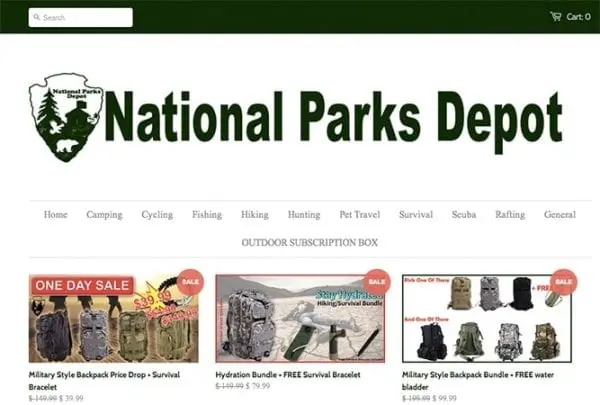
As Robert himself mentions in this case study, the odds seemed stacked against him.
He was an ex-felon, he didn’t have a lot of experience in sales and marketing and he wasn’t in a great financial position.
However, something about being an ex-felon drove him to want to be different and stand out. And that’s how he eventually created National Parks Depot, an eCommerce business that sells outdoor adventure gears and apparels.
Facebook Ads.
Starting with a small ad budget of $60, he got a return of nearly $1,000 in sales. He then doubled the ad spend and got back double his ROI. He eventually scaled up his ad spend and hit $80,000 in sales.
Don’t be afraid to spend money to promote your products. Even without much money, Robert was willing to invest to test if Facebook Ads would work for his business.
Invest money to get more sales, so test to see if paid advertising can work for your business.
14. How I Imported Gaming Glasses With Alibaba and Made $2,416.51 In 5 Weeks

This is the another Shopify challenge Shopify employees took on. In Example #8, we saw how they started a matcha green tea company from scratch in ONLY 3 days. In Example #13, we saw how they began selling t-shirts online in LESS than a month.
This time around, another Shopify employee Corey Ferreira took on the challenge and decided to set up an online eCommerce store selling blue-light blocking glasses for gamers.
The result this time?
$2,416.51 in 5 weeks.
Similar to the rest of the guys who took up challenges at Shopify, he ran through multiple marketing channels pretty quickly.
The one that generated the most sales for him was setting up affiliate commissions and getting influencers to help promote his product.
( Pro-Tip: Supercharge your influencer marketing, and get more word-of-mouth sales with ReferralCandy .)
Are there people who command massive audiences in your niche? Reach out to them and propose an affiliate deal, and get them to promote your product to their audience.
15. How One Ecommerce Entrepreneur Explored New Sales Channels – And Took Revenues From $8K to $96K per Month

Eating healthily is kind of a chore.
We all know we need to eat healthier, sleep more and work out, but we do none of that. Because we’re too busy.
Enter Raw Generation.
Raw Generation is a company that makes drinking raw, unpasteurized juice from fresh fruits and vegetables more convenient.
Deal sites.
After initially promoting on social media and getting no traction, Jessica, the founder was introduced to Lifebooker, a deal site.
After promoting on Lifebooker, they hit a home run.
Majority of Raw Generation’s sales come from deal sites like Groupon, Gilt and Rue La La. (They are no longer using Gilt or Rue La La.)
Once you discover a marketing channel that is working for you, don’t go seeking new marketing channels. Double down on it and make it work for you over and over again.
16. 80/20 Validation: The Cheap And Fast Way To Prove A Business
[caption id="attachment_22471" align="aligncenter" width="600"]

Image: Kettle and Fire [/caption]
What the bleep is bone broth? Well, It is a broth simmered from bones -- and it has been touted as a superfood by the paleo community.
It’s not easily accessible online.
Well, at least until Kettle & Fire came onto the scene.
Kettle & Fire became the first-ever company to make a unique shelf-stable beef bone broth. This particular bone broth need not be frozen until it is opened.
By making sure the product was something people wanted.
Yes, bone broth was growing in popularity.
But the bigger entrepreneur question is not about popularity, but “will anyone put money down for this product?”
Justin and Nick made sure of that by throwing up a landing page and driving Bing traffic to it (classic Four Hour Work Week-style.) The end result? A simple experiment like this netted them $500 in sales, which confirmed their entire business model.
Never assume your product is something the market will want. Always test to find out (be it through messaging people, sending paid traffic etc.)
Bonus #1: ReferralCandy Case Studies
We (ReferralCandy) have been accumulating case studies from eCommerce entrepreneurs from multiple industries to show you how they have succeeded.
Here’s the list of case studies we’ve done for you:
- Ecommerce Interviews
- Powder City
- BlissLights
- Magical Butter
- 1950 Collective
Bonus #2: BigCommerce Case Studies
Our aim here in this blog post is to create the most comprehensive resource you can refer to when you want to be inspired or simply to understand how successful eCommerce entrepreneurs think.
Caveat: These case studies mostly include promoting BigCommerce’s services… but look past that and you’ll discover gems.
- BombTech Golf
- Spearmint LOVE
- Exxel Outdoors
- Bohemian Traders
- Silk Road Teas
- Bulk Apothecary
- The Pink Lily Boutique
- Di Bruno Bros
- Sportbike Track Gear
- Twirly Girl
- US Patriot Tactical
- Con Olio Oils & Vinegars
- Raven and Lily
- LaQuan Smith
- Flash Tattoos
- Pappy & Company
Bonus #3: Reddit Case Studies
Reddit is an under-utilized resource for learning about successful eCommerce case studies.
In fact, hidden in the subreddit r/entrepreneur are countless “unknown” yet successful entrepreneurs who are more than willing to share their wins and lessons with a larger audience. Here are some of the most popular posts on Reddit that detailed step-by-step of how they succeeded:
- The Inner Workings Of A Subscription Box Company. From A 4K Site Purchase On Reddit to Close To $100,000 In Revenue In Less than 6 months. How We Did It, And What’s Next!
- I created DicksByMail.com, went viral, and sold the company before even shipping out my second round of orders. AMA
- How I literally started an Amazon business in about 1 month for about $1K
- 516 days ago at 20 years old I quit my job, dropped out of school, and founded an online hippie shop. This is how it turned out.
- Beardbrand's guide to building a brand
As previously said, we aim to make this list the most comprehensive eCommerce case studies list found on the Internet.
That being said…
Did we miss out on any? Which case study do you think we should include?
Let us know in the comments!
P.S. If you enjoyed reading this, subscribe to our newsletter where we share our latest articles and helpful resources .
Share this article on

Si Quan is ReferralCandy's Content Marketing Manager. He is also the co-founder of BreakDance Decoded , an online breakdance training company. He loves standup comedy, and has a dream to visit at least 100 countries in his lifetime.
- View all posts

14 Ecommerce Case Studies to Inspire You

We’ve spent hundreds of hours analyzing the world’s most successful DTC companies, including Sephora, Dollar Shave Club, Casper, Warby Parker, and Allbirds, to create ecommerce case studies you can use as inspiration for your own online store.
Today, we’ll share with you the 14 best ecommerce case studies that you can use to help drive more visitors to your website and convert more customers.
Let’s get right into it!
Shortcuts ✂️
- The Farmer’s Dog marketing strategy: 6 tactics that you can apply in your own business
- The secret behind the Care/of marketing strategy
- Dollar Shave Club marketing success
- How Casper took the mattress industry by storm and reached a $1.1 billion valuation
- How Glossier became a $1.2 billion company
- How Happy Box 10x-ed their online store revenue during Covid
- How Warby Parker reached a $3 billion valuation and became an ecommerce giant
- 4 steps for growing your brand organically using ColourPop’s marketing strategy
- Replicate Urban Outfitters’ marketing strategy with these 4 tips
- How Gymshark bulked up into a $1 billion+ brand
- How Allbirds went from a small startup to a billion-dollar sneaker brand in 4 years
- How Lunya achieved $25M revenue
- 6+1 tips from Rituals to create meaningful moments online
- 13 solid tips for mastering the art of personalization like Sephora
1. The Farmer’s Dog marketing strategy: 6 tactics that you can apply in your own business
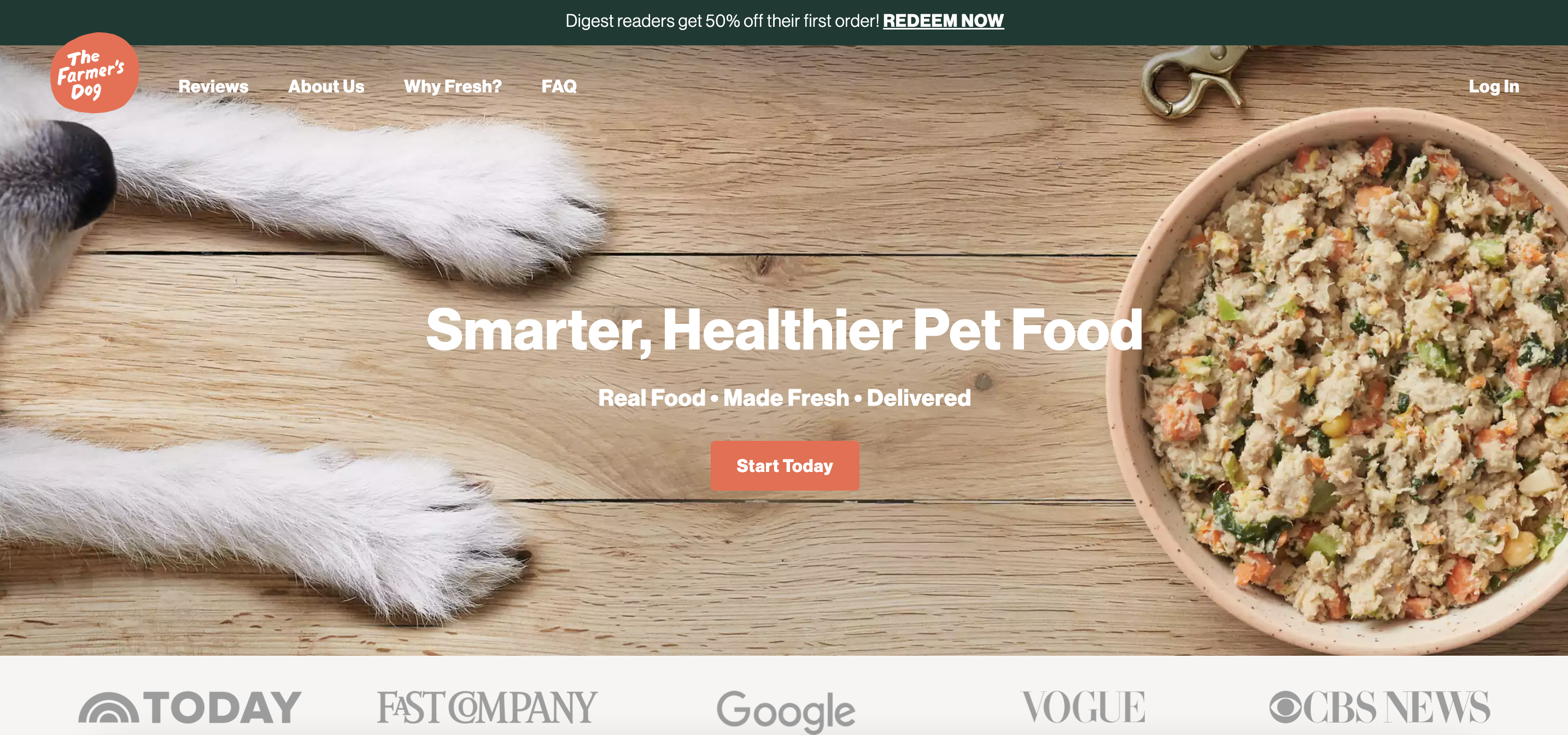
The Farmer’s Dog was founded in 2014 by two dog lovers. 6 years later, they’re delivering millions of meals monthly.
How did they do it?
We analyzed their sales funnel and boiled it down to 6 lessons you can apply in your own business to generate more sales.
Read the full The Farmer’s Dog case study .
2. The secret behind the Care/of marketing strategy
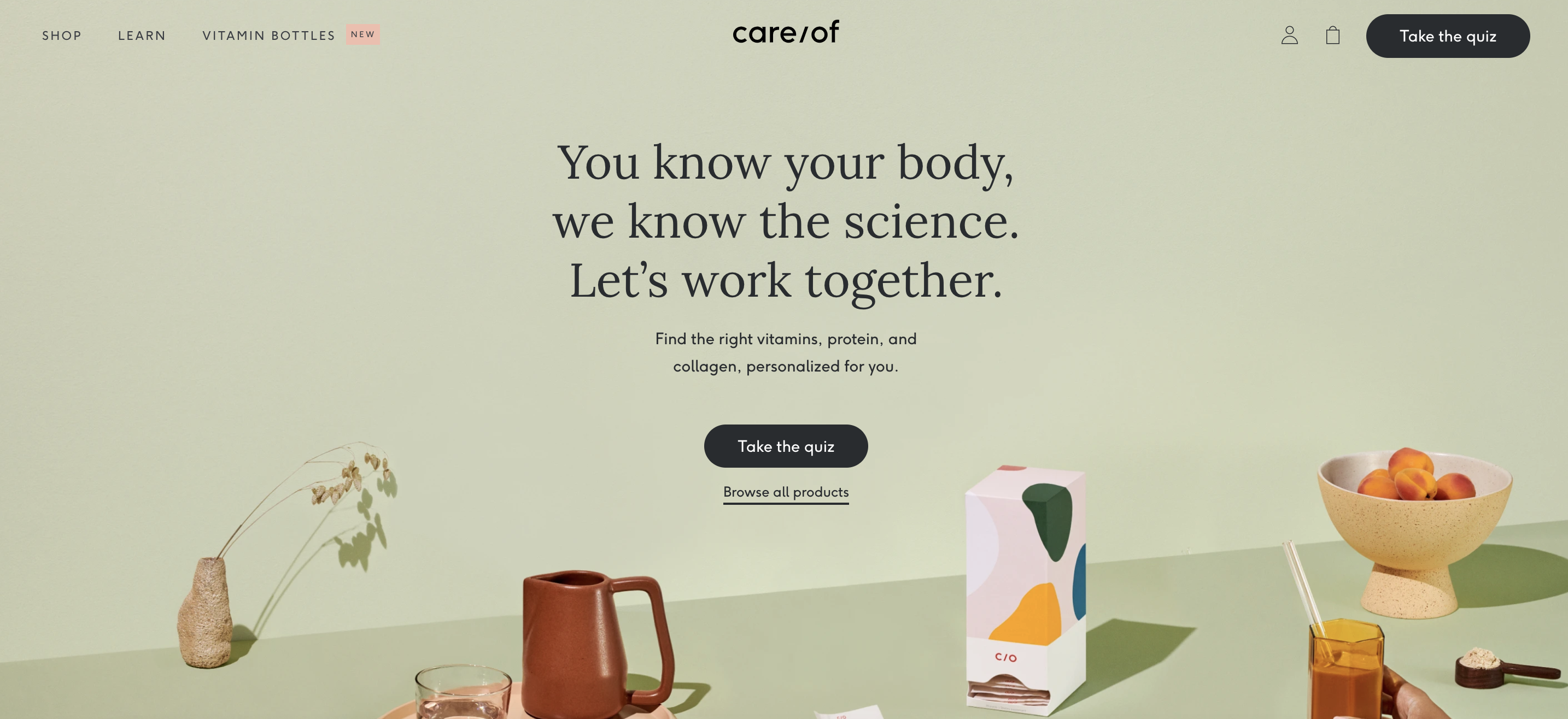
Every small ecommerce site owner dreams about a success story like Care/of’s. They achieved a $225 million valuation and were acquired by Bayer in just 6 years.
In this case study, we analyze the marketing strategies that Care/of used, including:
- Quiz funnel
- Content marketing
- Social media
- Paid advertising
Get inspired by these strategies to grow your own online sales.
Read the full Care/of case study .
3. Dollar Shave Club marketing success
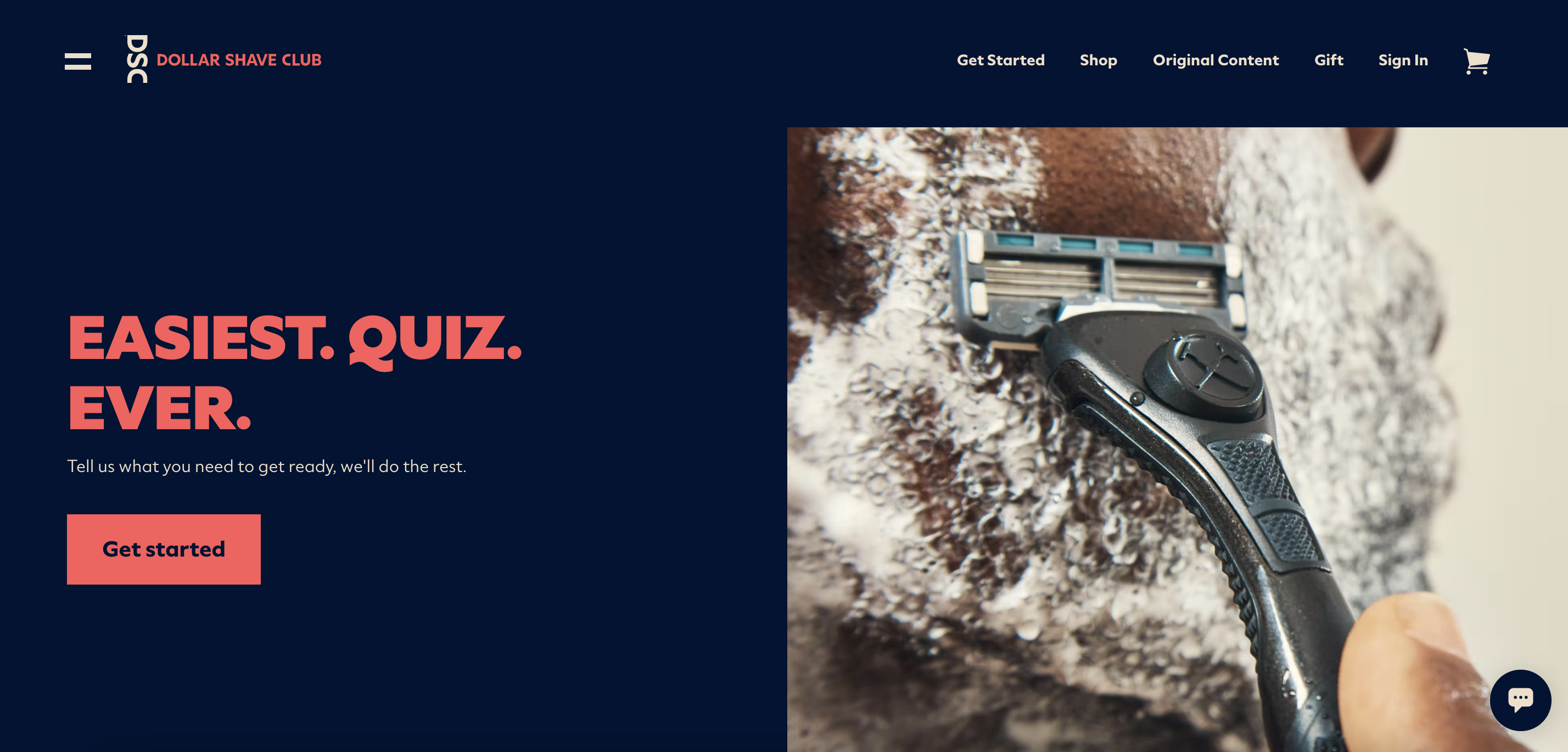
Dollar Shave Club is one of the most talked-about DTC brands, and with good reason. Their famous “our blades are f***ing great” video went viral in just a few days. The video went on to collect 4.75 million views in the first 3 months and has over 27 million views today.
This launch video gave them a killer head start, and their witty brand voice, strong content marketing campaigns, and direct-to-consumer business model enabled them to grow further. They were so successful that Unilever bought the company in a billion-dollar cash acquisition in 2016.
In this case study, we cover everything you need to know about Dollar Shave Club’s marketing game plan to build your own billion-dollar empire.
Read the full Dollar Shave Club case study .
4. How Casper took the mattress industry by storm and reached a $1.1 billion valuation
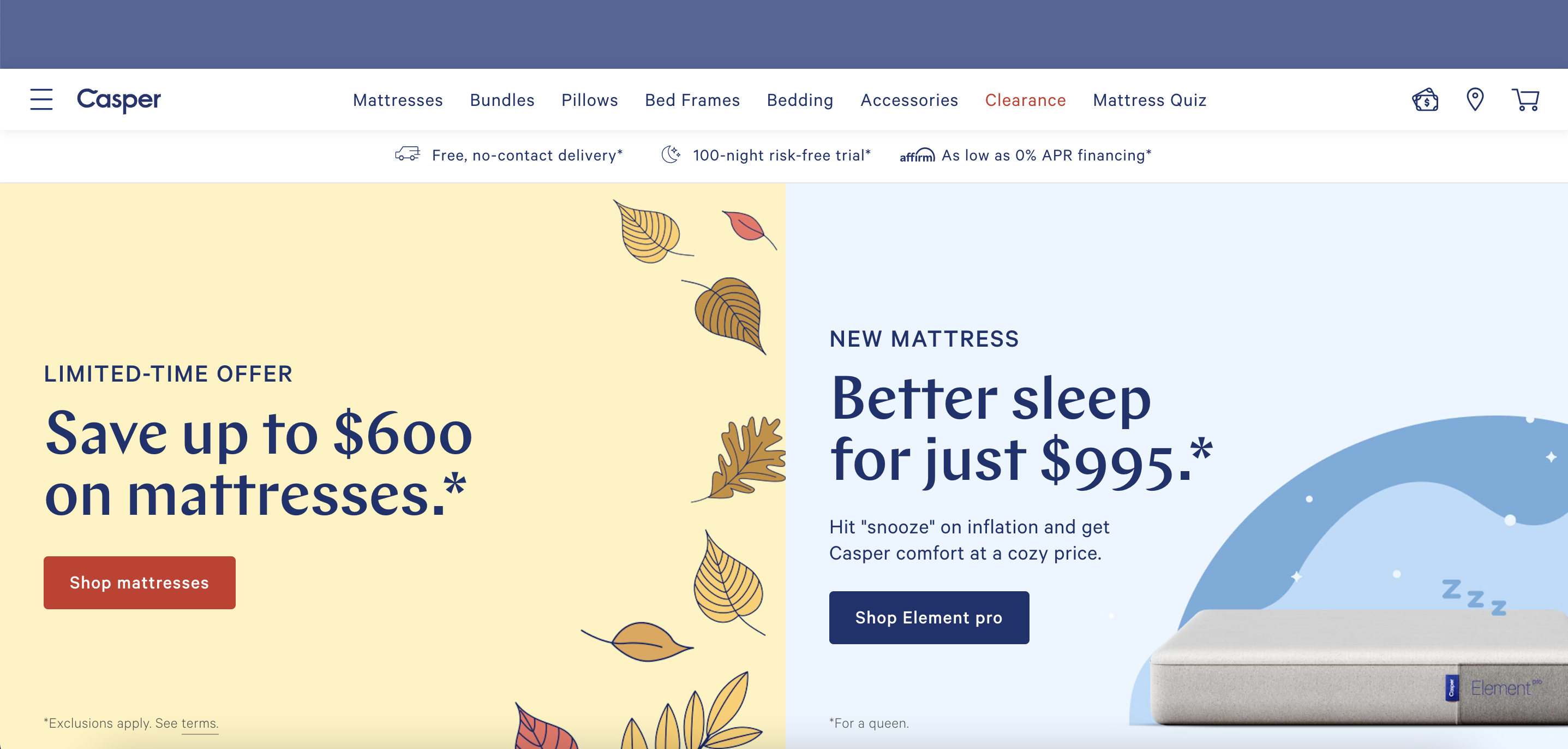
In this case study, you’ll get a sneak peek into how Casper was able to build unprecedented trust and convince people to purchase mattresses online.
We look at their well-rounded content marketing strategy, which covers topics of interest for visitors at every stage of the buyer’s journey.
We also discuss how they utilize social proof to build trust, their unbeatable guarantee, and their referral marketing strategies . Don’t miss this one!
Read the full Casper case study .
5. How Glossier became a $1.2 billion company
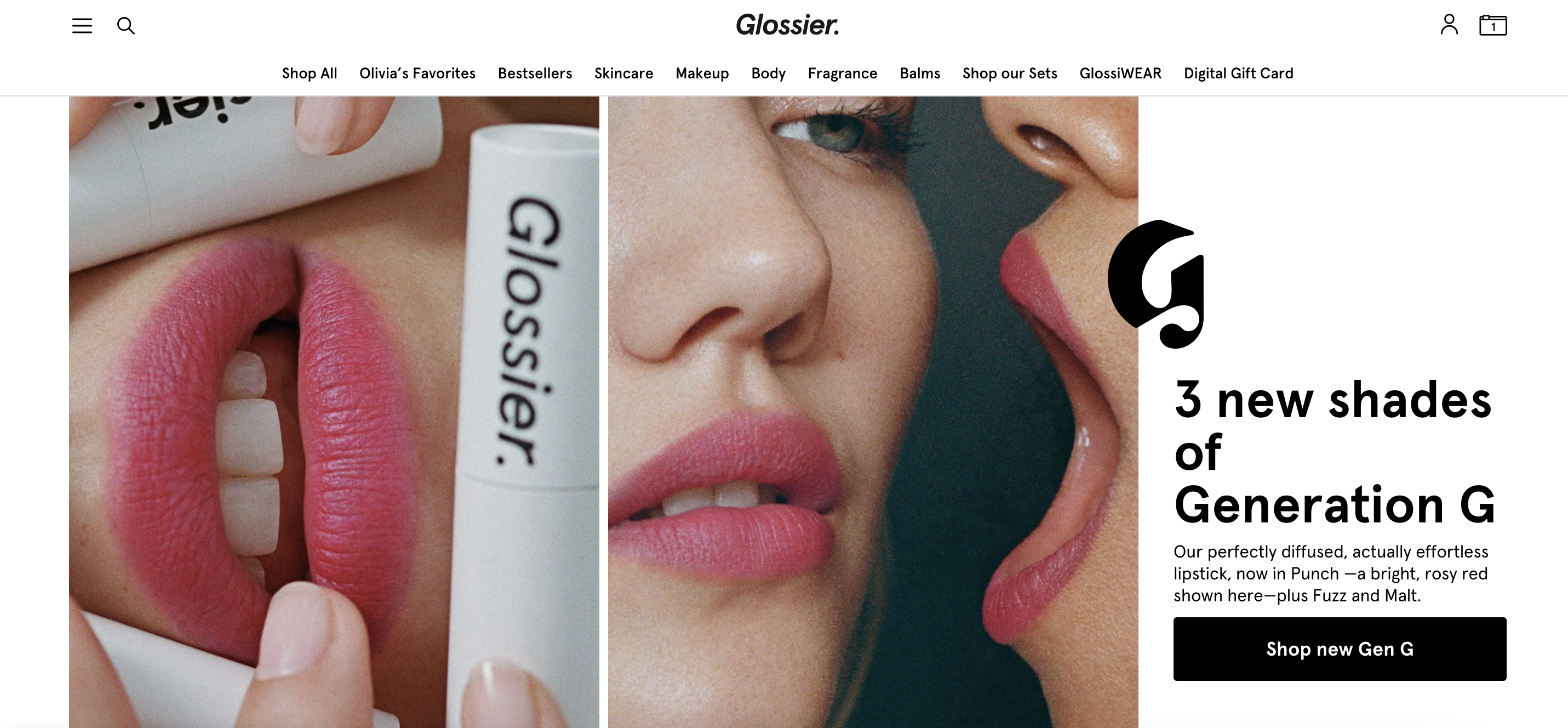
Glossier is one of our favorite ecommerce case studies. If you have a beauty brand, you’ll want to read it.
We’ve studied Glossier’s entire customer experience to find 5 lessons you can use for your own brand:
- Know your target audience and build relationships with them
- Use (micro-) influencer marketing
- Focus on branding
- Publish engaging content
- Provide an amazing user experience
Click the link below for all the juicy details.
Read the full Glossier case study .
6. How Happy Box 10x-ed their online store revenue during Covid
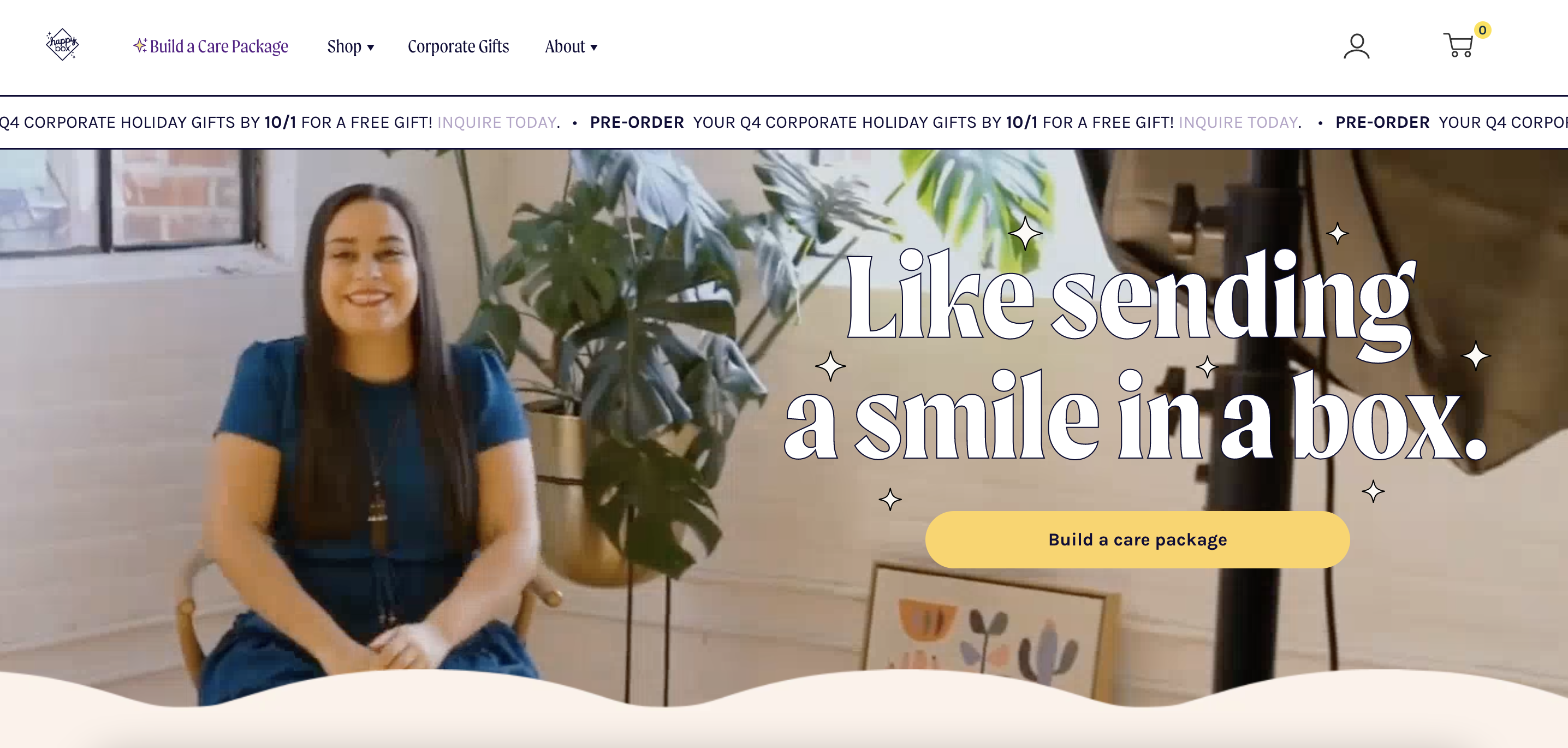
Happy Box is not as well-known as some of the other ecommerce stores on this list, but its growth is bound to inspire you. The company started as a side project and grew into a full-time ecommerce business during the Covid pandemic. In fact, they were able to achieve a 10x growth rate in 2021!
In this case study, we look at the marketing blueprint behind their astounding success.
Read the full Happy Box case study .
7. How Warby Parker reached a $3 billion valuation and became an ecommerce giant
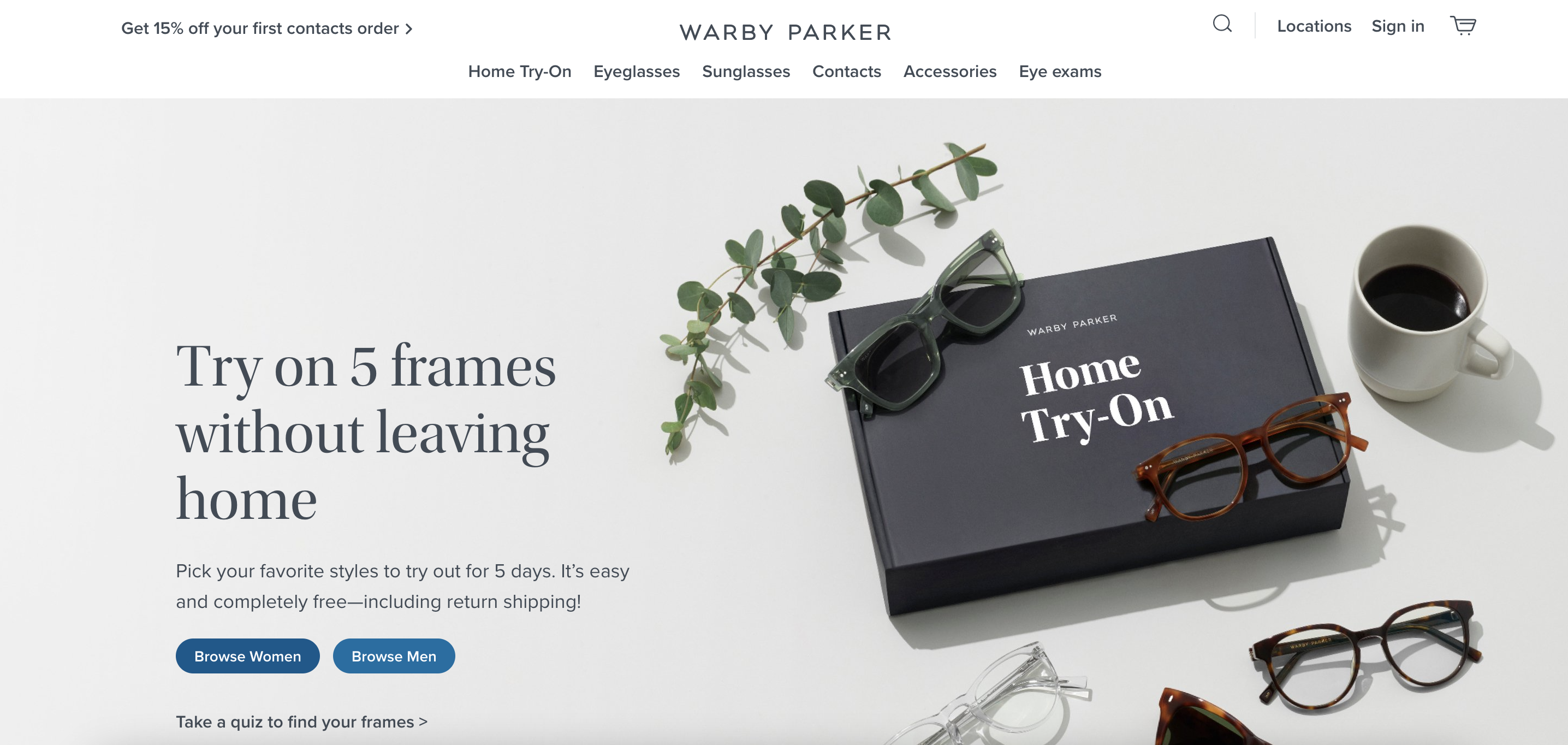
The idea of buying eyeglasses online was uncharted territory for consumers a decade ago. But Warby Parker’s phenomenal marketing helped to overcome that challenge.
Their website crashed just after its official launch, their top 15 most popular styles sold out within 4 weeks, and they collected a waitlist of 20,000 customers during that time.
In this post, we share the key strategy Warby Parker used to reach its target audience so quickly and went on to become the $3-billion giant everyone knows.
Read the full Warby Parker case study .
8. 4 steps for growing your brand organically using ColourPop’s marketing strategy
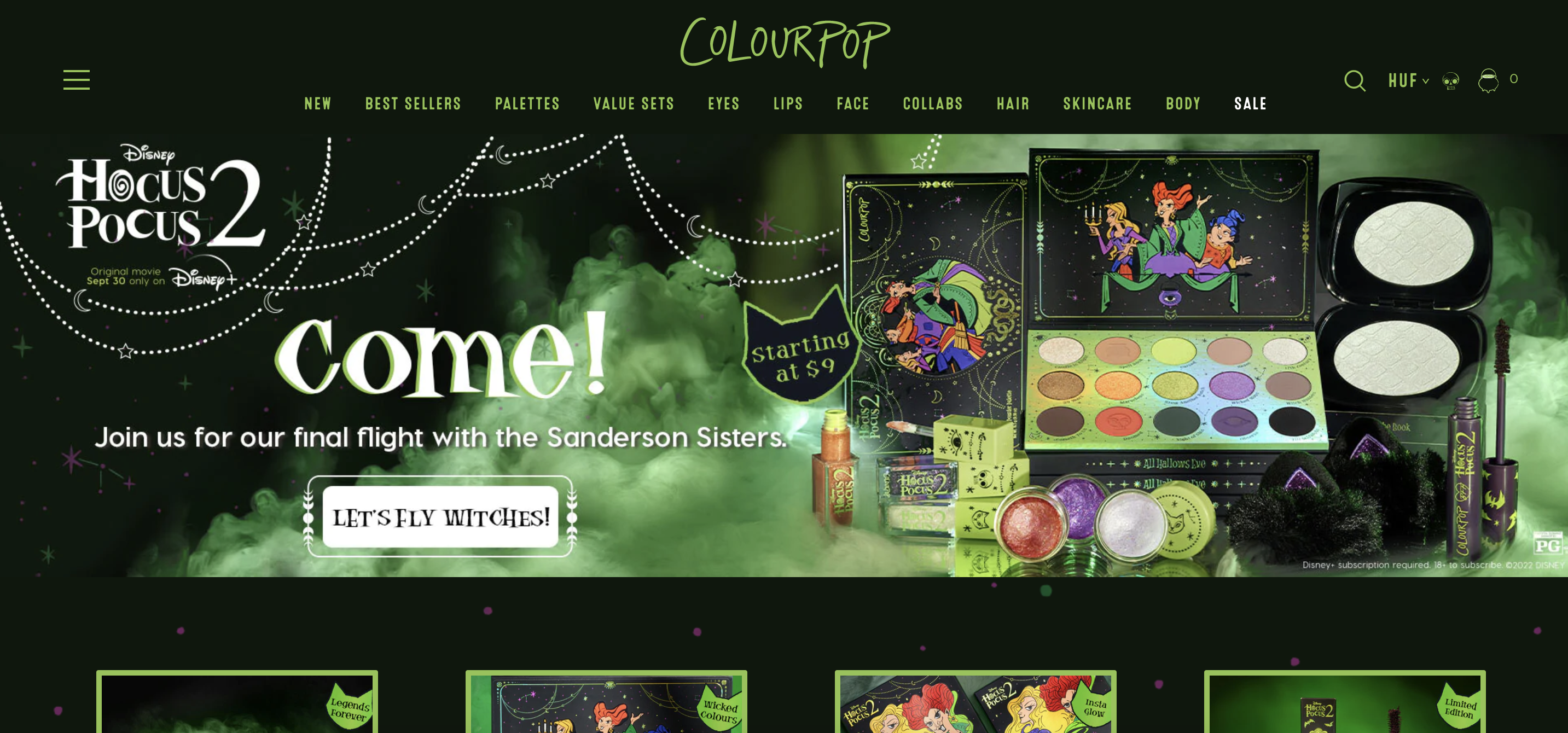
In this case study, we share 4 key takeaways from ColourPop’s winning social media strategy:
- Give freebies in exchange for authentic reviews
- Build meaningful relationships with your influencers
- Get your hashtag trending
- Host Instagram giveaways
Check out the tips that you can easily copy for your own ecommerce company.
Read the full ColourPop case study .
9. Replicate Urban Outfitters’ marketing strategy with these 4 tips
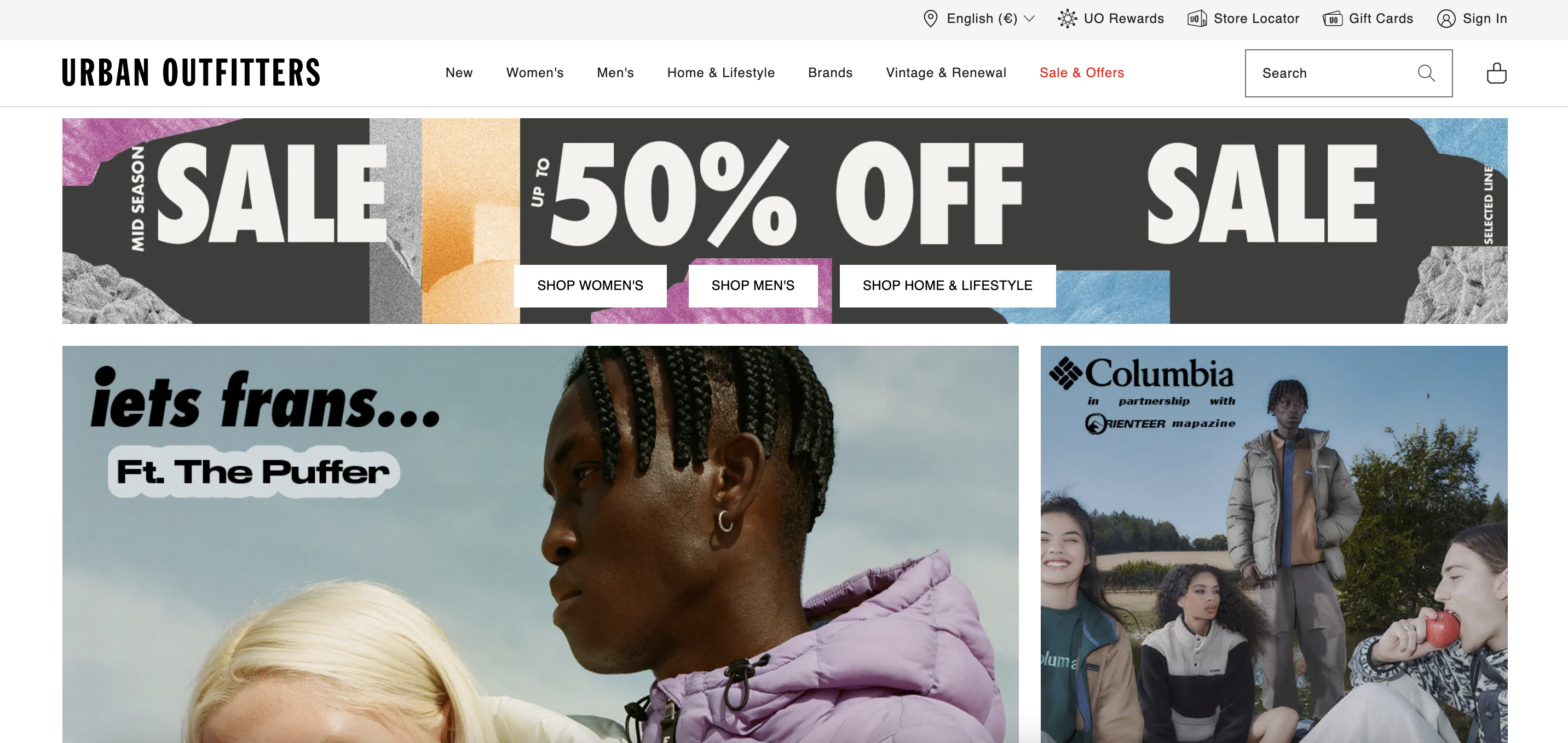
Urban Outfitters is different from a lot of the ecommerce brands on this list because they didn’t start online and grow into a global retail giant… instead, they started as a brick-and-mortar business (back in 1970) and managed to make the successful transition to online sales.
It’s worth talking about them because they’re fantastic at keeping in touch with their target audience (Millennials and Gen Z). They also succeed in strengthening customer loyalty with a rewards program.
Check out this case study to learn how you can do the same with your business to drive sales.
Read the full Urban Outfitters case study .
10. How Gymshark bulked up into a $1 billion+ brand
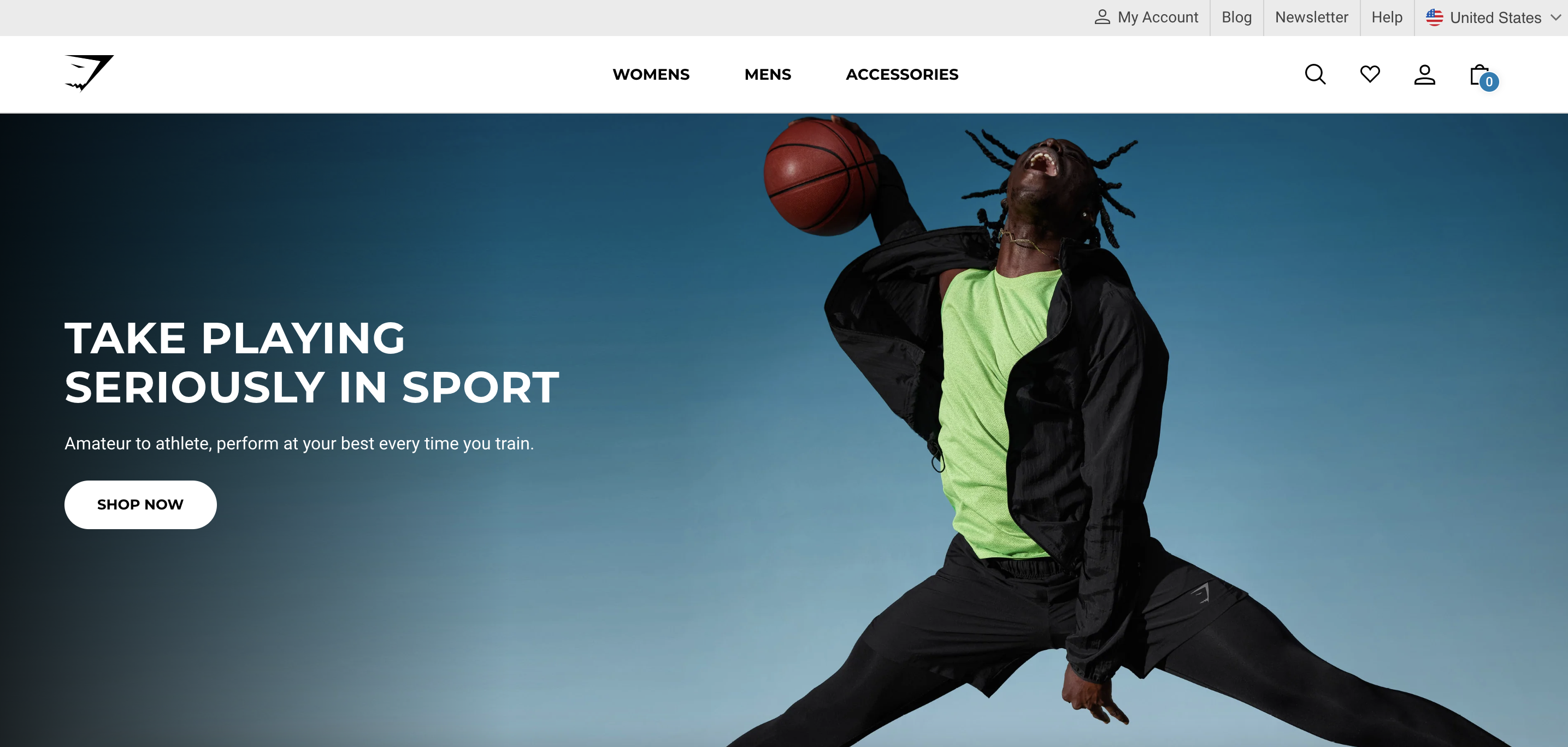
Gymshark is well known for its influencer marketing strategy. In fact, the company was one of the early adopters of influencer marketing.
In this case study, we cover how Gymshark managed to build its fan base, and we spill the beans on what they’re still doing today to delight customers. Check out our 6 key takeaways below!
Read the full Gymshark case study .
11. How Allbirds went from a small startup to a billion-dollar sneaker brand in 4 years
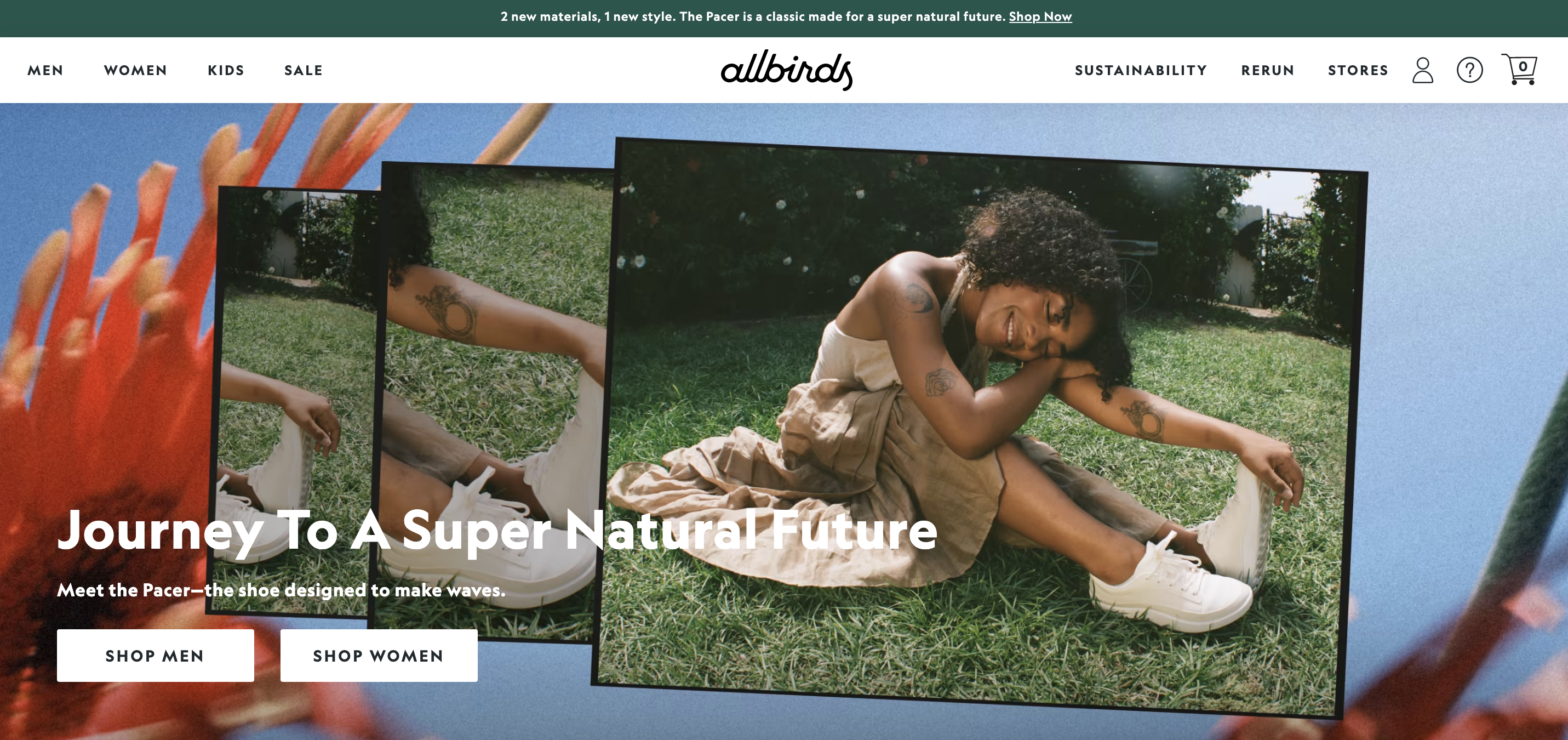
Allbirds is among the most popular ecommerce businesses, especially among circles of professionals in Silicon Valley, including Google co-founder Larry Page. The company differentiates itself from competitors by focusing on three important principles:
- Simple design
- Sustainable shoes, made from nature
Check out this case study to learn how they fight with their competitors, how they use PR campaigns and word-of-mouth marketing to get people talking about the brand, and more.
Read the full Allbirds case study .
12. How Lunya achieved $25M revenue

Lunya was able to disrupt the women’s sleepwear industry quickly by creating products that bridge the gap between style and sensibility. According to Lunya co-founder Ashley Merrill, the brand was able to grow by putting customers first and never losing sight of the customer’s perspective.
We analyzed the steps Lunya took to build their brand and create a successful customer-centric strategy.
Read the full Lunya case study .
13. 6+1 tips from Rituals to create meaningful moments online
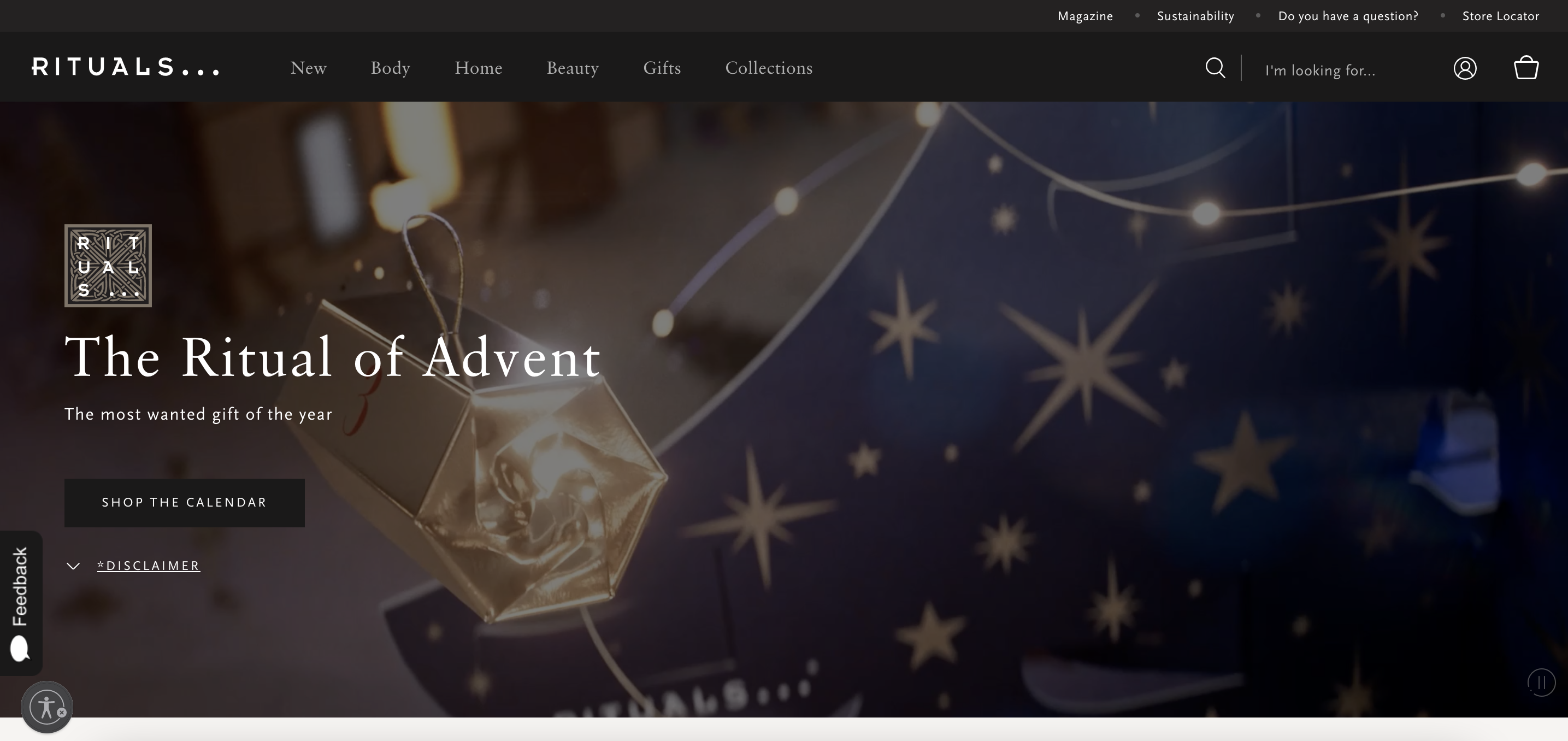
Rituals, founded in 2000, has an impressive product line including skincare, body care, makeup, and scented candles.
They really care about their customers and focus on creating an engaging customer experience online. We wanted to find out how they do it, so in this case study, we explore 6+1 tips from the marketing masters at Rituals.
Read the full Rituals case study .
14. 13 solid tips for mastering the art of personalization like Sephora
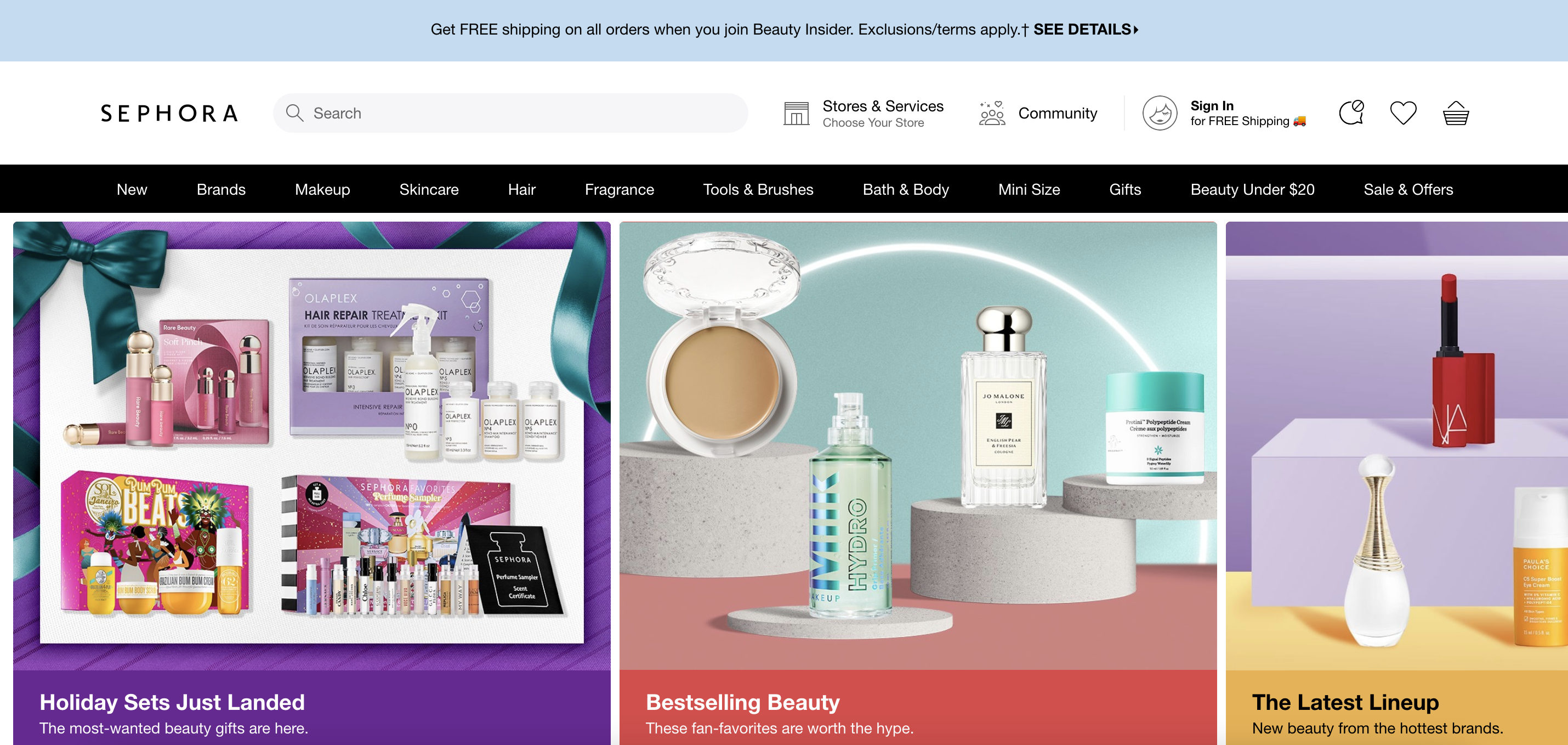
Sephora is a cosmetic behemoth that we can all learn from. What’s the secret behind their worldwide success?
In this case study, we share 13 tips they use to delight customers and create loyalty, including:
- Driving sales through personalization
- Helping customers make informed purchasing decisions
- Using YouTube to drive conversions
- Nurturing long-term customer relationships
Read the full Sephora case study .
Final thoughts
Well, that’s it—these are the best ecommerce case studies we’ve found during our extensive research! Hopefully you’ve found plenty of inspiration on this list.
No matter how big (or small) your company is or what industry you’re in, you can use tips and strategies from these case studies in your own store.
Which case study is your favorite? Let us know!
Nikolett Lorincz
You may also like.

Product Details Page: An Ultimate Guide for 2024

Affiliate Marketing Conversion Rate Benchmarks & Best Practices

25 Best Growth Hacking Resources for Business Growth
- Összes funkció
- Grow Your Email List
- Grow Your Messenger List
- Reduce Cart Abandonment
- Increase Avg. Cart Value
- Promote Special Offers
- Collect Customer Feedback
- Facilitate Social Sharing
- For Mid-Market/Enterprise users
- Partners program
- Terms & Conditions
- Security & Privacy
- We’re Hiring! ????
- eCommerce Guides
- Case Studies
- All features
- Book a demo
Partner with us
- Partner program
- Become an affiliate
- Agency program
- Success Stories
- We're hiring
- Tactic Library
- Help center / Support
- Optimonk vs. Optinmonster
- OptiMonk vs. Klaviyo
- OptiMonk vs. Privy
- OptiMonk vs. Dynamic Yield
- OptiMonk vs. Justuno
- OptiMonk vs. Nosto
- OptiMonk vs. VWo
- © OptiMonk. All rights reserved!
- Terms of Use
- Privacy Policy
- Cookie Policy
Product updates: Introducing OptiMonk AI

10 B2B Ecommerce Case Studies to Inspire You

Running a B2B ecommerce business can sometimes be a challenge — especially if you’re new to using an ecommerce platform . Doing your research and browsing a few extant B2B ecommerce examples can be a great way to launch your own business, or upscale a current one.
There are many complexities to running a B2B business that you might not encounter in other forms of ecommerce, like B2C.
From processing complex orders, engaging with your audience, and optimizing your site for inbound marketing, a lot goes into managing an ecommerce website.
While it can often seem like a journey of trials and errors, there’s no doubt that your business will benefit from having a greater presence online. It’s time to set your sights on writing your own ecommerce success story.
Read on to find out more and check out a few successful B2B ecommerce examples to inspire your own story.
In this B2B ecommerce guide:
What is B2B ecommerce – and how does it work?
How is b2b ecommerce changing.
- 10 Inspiring B2B ecommerce brand stories
Lessons from top B2B ecommerce brands
- Frequently asked questions
Business-to-business (B2B) ecommerce is the sale of products between businesses, conducted on an online website. Products are displayed on a website and orders can be placed with the business via an online portal. The seller then ships the items to the recipients given delivery address.
All kinds of products can be sold online – from software and furniture, to clothing and cooking utensils.
The B2B world is evolving. Digital marketplaces must constantly evolve to keep up with changing technology and consumer demands. Brands which don’t deliver on the latest customer expectations often soon disappear.
The line between B2B (business-to-business) and B2C (business-to-consumer) is becoming ever more blurred. Many of the traditional B2B ecommerce companies sell to consumers and vice versa.
Advantages of B2B
Before you take a look at some B2B examples, it can be helpful to know what sort of advantages you’re on the lookout for. Some of the benefits of a B2B ecommerce operation include:
- Digital location. Your shop exists digitally with an ecommerce platform. There’s no requirement for a physical business space. You might need to consider warehouse storage for your stock, depending on your business operation. However, there are ways to run a business without owning any stock at all, like dropshipping.
- Profit margins. Shop floor. Warehouse. Staff hires. There’s no need for any of these expenses with an ecommerce store. Lower overhead increases the potential for higher profits, as you’ll get to keep a larger percentage of your sales totals.
- Scalability. B2B platforms are scalable. By adopting new technologies, like cloud computing, you can expand accessibility across the globe – supercharging your business’ growth potential.
- Customer base. Likewise, as your B2B platform reaches a global audience, you can expand the size of your customer base exponentially – vastly increasing the likelihood of improved profits.
- Analytics. Integrating customer data software, like an Order Management System, can enable you to track and store important customer data, which you can leverage to make data-driven decisions in future.
10 inspiring B2B ecommerce brand stories
The success of your B2B ecommerce business relies not only on designing a great website and adding a few calls-to-action.
From choosing the right ecommerce platform to branding to showcasing your products, a lot of planning and strategy goes into creating an attractive and lucrative online store.
Study these 10 brands and see how they mastered the art of selling online, gained brand awareness, and even doubled their business revenue.
1. The global expansion of Rubik’s.
Everyone knows the Rubik’s Cube is the #1 selling puzzle game in history. So when Rubik’s decided to take their business online, they knew that they had the opportunity to broaden their reach and increase their revenue.
According to Rubik’s ecommerce and Digital Marketing Director, Fabrice Druelle, Rubik’s was in the market for an ecommerce platform that would allow them to scale their business and expand to new countries.

“We needed a scalable solution… with a high level of flexibility,” said Druelle.
With Adobe Commerce, Rubik’s was able to launch quickly. Within four months, their customer experience moved from a catalog-based site to a more interactive experience–with more options for toy distributors, fresh content, a new check out process, and a wider range of features.
Their (UK) revenue increased by 150% in the first six months and their conversion rate doubled.
In Rubik’s case, choosing a more flexible and scalable ecommerce platform enabled them to grow their business significantly and offer a better experience to their distributors and customers.
Read the full Rubik’s case study
2. Planning for the future with HP.
HP manufactures computers, workstations, and printers for businesses and consumers alike.
When they decided to expand their Asia-Pacific division (and open five online stores), they realized they needed to work on a B2B ecommerce business plan that was future-ready but still had a “local feel.”

HP turned to Adobe Commerce for a platform that could support multiple stores globally. With the best in site navigation, design templates, and on-site security, Adobe Commerce was an obvious choice when it came to expanding their B2B ecommerce website.
Creating several new online stores in different regions came with its own set of obstacles–particularly in terms of content, processing payments, and language translation. They built the right website for their company, the transition was seamless and the payoff was significant.
The result was a more “local” feel for users online and a movement of 23% of users opting to purchase their products online as opposed to at an in-person store.
Read more about HP and their success with Adobe Commerce
3. Building projects made easy with Selco.
Selco Builders Warehouse is a British brand that connects building contractors and tradespeople with building material products.
As a B2B sales company that values digital expansion and creative advertising, Selco utilized the Adobe platform to connect with entrepreneurs and businesses online. However, they recognized that contractors are busy people, so they wanted to eliminate the headaches of searching for materials and tools in a vast catalog.

To help their audience find what they need faster, they created the Project Tool App. This app assists tradespeople with project management – finding products online and communicating with their team, no matter where they are.
Selco was able to see a gap in the market for something that would connect their customer base with what they needed, faster. By discovering new ways to invest in digital technologies, they were able to generate 600,000+ more website visits, sell more products online, and create an all-in-one solution for their customers.
Learn more about this Selco innovation
4. A BAUHAUS B2B empire.
BAUHAUS is a well-known German home improvement company with a legacy of quality products and over 250 stores across Europe. They specialize in home improvement, gardening, tools, and outdoor living.
Their B2B ecommerce journey started with Adobe Commerce in the early 2010s, when they first opened their digital store. BAUHAUS has grown to offer over 50,000 products and has seen a 296% increase in online revenue in the past decade.

By taking their longstanding business online, they were able to increase their reach and offer more products, which led to a 376% increase in conversion rates. Theirs is a lesson in keeping up with the latest technologies and seeing the potential in expanding to new platforms.
Read the entire BAUHAUS story
5. A cool B2B solution for Watsco.
When things heat up in the summer, you need a cool solution. But when business started heating up for the HVAC company Watsco, they needed a cool way to expand their business online.
With Watsco, AC installation is just a call or click away. They order the parts, install it, and share everything you need to feel chill and relaxed.
Watsco also helps contractors in the HVAC industry do their jobs more efficiently by connecting them with the supplies that they need and forging partnerships to increase revenue.

Their B2B ecommerce strategy has resulted in 50% growth year-over-year, expansion to 500 locations, and over $900 million in sales.
Paul McCluskey, the Director of Ecommerce at Watsco , said of Adobe Commerce:
“The goal was to find a platform that had a large community of resources to draw from, was capable of enterprise-level order volumes, was backed by a leadership team with a solid industry reputation and a passion for driving innovation... Adobe matched all of these criteria.”
6. Fixing complex problems for Vink VTS.
Vink VTS is a plastics company that delivers a wide range of plastic materials to businesses. The industries they serve include construction, manufacturing, automotive, medicine, transportation, and many others.
While they have dominated the space, serving over 120,000 customers online and beyond, they needed to address some complex issues in their business to provide a better experience and generate more revenue.

They needed to move from their existing tailor-made platform to something more agile. So they built a new Adobe Commerce platform. This allowed B2B customers to see all deliveries, order, and invoices online in real time.
This re-working of their ecommerce platforms allowed for more flexibility and overall scalability. The result was a 160% increase in website orders and a movement from internal sales calls to online orders.
Find the full Vink VTS case study
7. Double the sales for Rubie’s Costumes.
Have you ever dressed up as your favorite movie or television show character for Halloween? If so, it’s likely that you wore a costume made by the costume manufacturer Rubie’s.
Rubie’s is the largest manufacturer of licensed costumes in the world and absolutely dominate their industry. From Star Wars to superheroes, more than 50% of all character costumes are made by Rubie’s and distributed to costume stores across the world.

While Rubie’s does sell costumes direct to customers online, B2B sales are their main focus. By updating their ecommerce operation, they have been able to reach more entrepreneurs, party stores, and re-sellers.
They have since been able to double their online orders year-over-year through allowing users to place orders online. This has resulted in a faster purchasing process and a better user experience.
8. Going modern with Steelcase.
Sometimes businesses just hit a roadblock when it comes to their existing ecommerce platform . Maybe the backend is clunky, features are limited, their website is lagging, or it just makes scalability difficult.
Steelcase, a B2B company in the office furniture industry, ran into a few of these issues with their existing platform and decided they needed to make a change. They needed something modern and flexible.

Since Steelcase serves customers of all sizes and works with a wide network of dealers, it was important that their ecommerce site showcase their vast range of build-to-order products and ordering options.
A shift to Adobe Commerce meant offering over 25 quadrillion (yes, you read that right) SKUs expanding to 1,000s of new B2B websites.
“Adobe Commerce is a modern, flexible platform that allows us to present our complex product offering to customers in a friendly, approachable, and easy-to-understand way. It’s aligned with our brand and what customers expect from a modern online shopping experience.”
9. Better UX for Intelligentsia Coffee.
Everyone loves a good cup of Joe. Intelligentsia, the Chicago-based coffee retailer, delivers the best coffees from Central America, South America, and beyond to their customers and distributors.
Their success is built on solid relationships with growers and their high standards for responsible, ethical farming.

Since they also sell coffee to grocery stores, restaurants, and wholesale businesses (in addition to B2C), they needed an ecommerce platform built to accommodate all kinds of orders.
To unify their B2B and B2C business, they worked to combine multiple product catalogs on the backend. This streamlined the process for customers and resulted in a better, more mobile-friendly user experience. With Adobe Commerce, Intelligentsia was able to integrate their sites seamlessly with their existing systems.
A better purchase experience led to a 16% increase in mobile transactions, a 40% increase overall, and their conversion rate increased by 20%. Big wins for these coffee connoisseurs.
10. Rainbow Treecare goes national.
Rainbow Treecare, a tree and plant health care company, wanted to take their business international. They used Adobe Commerce 2.2 to make it happen.
Their B2B sales business consists of developing a range of healthcare products for tree care professionals, landscapers, and government agencies. They provide affordable, sustainable solutions to caring for trees and plants in cities, neighborhoods, and beyond.

They were looking to grow their ecommerce business by expanding internationally and having a more enhanced online presence. While their existing presence was more about education, they started implementing online store ordering.
“The goal was to extend the backend API to enable communication between [all] systems, so that all customer, product, and order information... could be shared with Adobe Commerce. It also connected with existing credit and payment processing capabilities, so customers could easily place online orders for the first time.”
The new website opened up new markets to Rainbow Treecare, allowing them to process more orders than ever before and increase their revenue. Now customers everywhere are accessing their site via mobile and are even ordering outside of regular business hours.
Countless brands have taken their businesses online, opening online stores and investing in their own B2B ecommerce platform .
The success of these brands depends on a combination of the right platform, the right message, and the right marketing strategy. The business case studies above represent B2B companies that understand the necessity to keep up with the changing times and the value in providing new solutions to complex problems.
The top B2B ecommerce brands know how to:
- Fill the gaps and solve problems for their customers.
- Provide valuable, educational content.
- Save time and money for themselves and their B2B customers.
- Expand to new markets and offer innovative products.
- Choose an ecommerce platform that will evolve with their business.
- Invest in digital technologies.
- Increase brand loyalty through better customer support.
- Keep up with business trends, events , and the latest marketing strategies
- Stay true to their brand message, legacy, and mission
There are plenty of benefits to launching an ecommerce business and the sector is only on the rise.
Frequently asked B2B ecommerce questions
What are the four types of ecommerce business.
The four types of ecommerce examples are: B2B (business-to-business), B2C (business-to-consumer), C2B (consumer-to-business) and C2C (consumer-to-consumer).
How is the B2B buyer journey different from that of B2C?
Traditionally, B2B sales might be for large order items and higher demand, like paper sales or software for a business’ IT department. Meanwhile, B2C purchases are usually for an individual and are, therefore, much smaller in scale.
What are B2B products?
B2B businesses offer a wide range of products. All those other businesses may need. From printing paper and stationary to mechanical equipment and factory machines.
Related content:
- Top 5 B2B ecommerce predictions for industrial manufacturers in 2022
- Add personalized product recommendations into your B2B commerce growth strategy
- Ecommerce Mistakes to Avoid

Don't have a Shopify store?
Top 10 Inspiring E-Commerce Case Studies To Learn From
CEO Avada Commerce

Maintaining relevance should be a primary concern in the fiercely competitive realm of digital commerce.
With that in mind, in this article, we’ve compiled the following eight real-world e-commerce business case studies to assist you in attracting more customers and boosting revenue.
Key Takeaways
- The article highlights 10 businesses that enhanced their e-commerce performance using Bloomreach solutions, including Bosch, Topdanmark, The Vitamin Shoppe, Albertsons, HD Supply, My Jewellerry, Debra’s, Burrow, Rakuten 24, and Al-Bahar.

Bosch Power Tools, part of the global Bosch Group, understands the importance of keeping pace with industry trends, especially those influenced by Amazon. Their case study about e-commerce is among the most famous examples of how an eCommerce brand overcomes its challenges.
Given their multiple international sites, Bosch recognized the need for a tailored digital experience for its customers. Their main challenge was offering unique experiences for each country while presenting a cohesive global presence.
Bosch established uniform technology systems and processes to address this challenge. This wasn’t just about control but about boosting momentum in every region.
Bosch then adopted a headless commerce approach, paired with Bloomreach Content. Unlike traditional systems, headless commerce separates the back and front ends. Combined with Bloomreach Content, this strategy allows Bosch to update the front end without disrupting operations, making processes more efficient.
As a result, Bosch can now quickly introduce features worldwide, aligning with the company’s goals and offering custom experiences from one country to another.
Additionally, Bosch has teamed up with Bloomreach and SAP. The Bloomreach Commerce Experience Cloud integrates seamlessly with the SAP Commerce Cloud, a key component of SAP’s Industry Cloud Program available on the SAP Store. This partnership enables Bosch to offer personalized experiences across all channels for every customer journey.

Topdanmark, Denmark’s second-largest insurance company, is committed to managing insurance and pension schemes for its customers while building trust. As it advances in the digital realm with Bloomreach Content, Topdanmark encountered challenges common to many financial services companies.
The main challenges of Tondanmark include dealing with cumbersome legacy systems filled with customer data and creating custom customer elements rapidly. In choosing a platform for their digital experience, Topdanmark sought a solution that met three critical criteria:
- Ongoing product development.
- An easier way to share content across multiple brands.
- A customer-centric online experience.
Solutions
Topdanmark sought a continually updated platform with a vibrant developer community capable of integrating with top-tier technologies and enabling its developers to enhance user experiences. Thus, they turned their attention to open-architecture CMS platforms.
For them, flexibility was crucial. They needed to test and assess new features for customers quickly. This includes letting customers easily enhance their primary insurance coverage. After seeing vital positive feedback, they made this feature a permanent option.
In their search for a platform that supported rapid innovation, Topdanmark found Bloomreach Content to be the perfect fit. With Bloomreach Content, Topdanmark smoothly shifted 500 URLs over 13 two-week periods. They also set up a responsive CMS designed for current and future efficiency.
The Vitamin Shoppe

The Vitamin Shoppe®, a global wellness retailer, offers customers reliable products, advice, and services for their wellness journey. They observed that, although their search function efficiently helped customers find specific items, there was room to enhance their category browsing experience.
A Health Enthusiast would help uncertain customers by recommending products tailored to their needs in physical stores. Yet, before using Bloomreach, The Vitamin Shoppe had no online system to offer this level of personalized guidance.
To address and optimize its category pages, The Vitamin Shoppe incorporated Bloomreach Search and Merchandising to entice more site visitors into exploring and searching for products.
Upon deploying Bloomreach Discovery, The Vitamin Shoppe witnessed an uplift of 11% in the add-to-cart rate for category pages. Additionally, there was a 2% surge in revenue per visitor (RPV) for those who initiated their journey via these category pages.
In the realm of search pages, after a mere two weeks post-implementation, The Vitamin Shoppe observed a 7.73% enhancement in the search add-to-cart rate, a 6.51% ascent in the search average order value (AOV), and a 5.69% rise in RPV (Source: bloomreach ).
These advancements boosted The Vitamin Shoppe’s revenue and enriched the shopping experience for their customers, further aiding them in their pursuit of wellness objectives.

Albertsons – an e-commerce case study
Albertsons, a company committed to delivering a consistent and unique omnichannel customer experience, has always been at the forefront of e-commerce innovation. As one of the first grocery chains to initiate online delivery in the 2000s, Albertsons has consistently strived to offer customers personalized content that enhances brand loyalty, making it one of the most innovative grocery brands in the market.
Albertsons saw that over half of e-commerce sales came from search and knew they needed better search results for their loyal customers.
In physical stores, shoppers usually start with a list and know where items are. Online, they begin with a search. Bloomreach Discovery’s Semantic Search uses natural language processing, detailed attribute extraction, and previous visitor actions to show the most relevant products.
Thanks to Bloomreach Discovery, Albertsons used artificial intelligence to give sharper search results, making their brand experience more personal for shoppers. Beyond tailored search results, Albertsons also began suggesting products using Bloomreach’s algorithms.
After adding Bloomreach Discovery, Albertsons saw a 25% jump in the speed of building shopping baskets, showing that customers found what they wanted faster.

HD Supply, a large company, is updating its digital strategy to address ongoing challenges and better serve customers in today’s digital world. Their e-commerce team looked into their current systems and how customers used them. They found that customers wanted a faster, more dependable way to buy items.
So, HD Supply focused on making it easier for customers to quickly find and buy products, helping them return to their day. A vital part of this was upgrading the add-to-cart feature.
HD Supply realized that using ready-made technology would reduce the need for heavy changes later. So, they picked Bloomreach Discovery for their site search needs.
Understanding customers wanted faster shopping, HD Supply revamped its search feature. Customers can see product details from the search bar and add items to their cart directly.
HD Supply used the Bloomreach algorithm for most search results to lighten their team’s load. The company noticed a 16% rise in search-related revenue thanks to these changes, showing how well the Bloomreach system works.
My Jewellery

My Jewellery – an e-commerce case study
In a world where consumers are increasingly concerned about data protection, businesses are becoming more cautious about data collection. This includes My Jewellery, a Netherlands-based clothing and jewelry retailer. My Jewellery aims to enhance the customer experience for its loyal patrons while respecting their personal data privacy.
My Jewellery used Bloomreach Engagement to lead in collecting zero-party data. They introduced a unique approach that engages customers while valuing their privacy.
With their “style profile test,” customers simply indicate if they like a shown item. This game boosts customer experience without compromising privacy. Items appear individually; customers click a heart or X to share their tastes. Based on this, My Jewellery creates a personalized style profile.
After sharing an email, customers get their style profile based on their choices. This method has proven beneficial. Emails using style profile data had a 20% higher open rate than regular campaigns, highlighting the importance of such innovative data collection.

DeBra’s, an Australian company specializing in women’s undergarments, lingerie, and swimwear since 2000, has seen substantial growth in online and offline channels over the past 21 years.
The advancement of modern technologies led to DeBra’s online business exceeding its expectations, necessitating a new online platform to facilitate future growth. Amid the COVID-19 pandemic, with the surge in women shopping online, DeBra’s aimed to ensure their online presence could deliver a digital experience equivalent to an in-store fitting.
DeBra’s team identified BigCommerce as the optimal solution for their business, logistics, and marketing needs. BigCommerce’s open API functionality allowed DeBra’s website to easily integrate with other technologies, such as a POS system, enhancing its marketing and customer experience.
BigCommerce also enabled DeBra’s to launch a virtual fitting service. Their in-store staff serves as virtual assistants in this service, helping customers enjoy a professional, digitally appropriate experience.

Burrow – an e-commerce case study
Burrow, a B2C furniture store established in 2017, was founded to eliminate the inconveniences of traditional furniture shopping. However, once their business achieved $3 million in sales, they encountered system issues with their existing online platform. Their business growth had outpaced their eCommerce solution.
Additionally, the Burrow team needed practical content management tools that would allow them to update landing pages without requiring extensive technical expertise.
Burrow separated their website’s front and back ends using headless commerce. This approach provided them with the flexibility to create a unique shopping experience. Thanks to a headless CMS, the Burrow team could freely use available templates and customize marketing-focused content as needed.
They could continually update and adjust content across channels to align with targeted customers. Furthermore, Burrow recognized the importance of offering customers unique logistical features, including the ability to delay orders and require signatures on delivery.

Rakuten 24, an online branch of Japan’s top e-commerce company, Rakuten, sells everyday items like groceries and healthcare products. Seeing the fast rise of mobile shopping, Rakuten 24 aimed to create a top-notch mobile experience for its users.
Although Rakuten 24 is newer to Japanese consumers, pouring a lot of resources into making specific apps for iOS and Android might not be the best move. Instead, they felt a well-designed, user-friendly mobile website could be a more innovative alternative for Rakuten 24’s mobile presence.
Rakuten 24 built a Progressive Web App (PWA) to increase market share and improve user retention to deliver a seamless web experience across all browsers. Their PWA successfully combined the best features of native apps with the extensive reach of the mobile web. Rakuten 24 also provided a detailed guide on manually installing the PWA on Android and iOS devices for mobile web users.

Based in Kuwait, Al-Bahar is a leading supplier of FMCG products, electronics, and office tools from top brands like Unilever and GE. It’s a trusted name in the Middle East. However, despite its strong reputation and heavy website traffic,
Al-Bahar faced web issues like slow speeds and frequent downtimes. The main causes were poor hosting choices, an outdated CMS, and using Magento 1, which was no longer supported.
Given the website’s needs, a significant overhaul was in order, but this came with risks like data loss and compatibility problems. Al-Bahar needed to be careful.
After teaming up with SimiCart, a recognized PWA development agency, Al-Bahar updated its site based on SimiCart’s guidance. SimiCart suggested transitioning the front end to a Magento PWA and shifting from Magento 1 to Magento 2 for the backend.
This transition not only ensured data preservation but also boosted the store. With a PWA interface, Al-Bahar enjoys faster speeds, greater adaptability, and a smoother user shopping experience.
Bottom line
These eCommerce case studies unveil novel strategies and tactics on how others have tackled challenges in the eCommerce field. You can learn from their experiences to overcome challenges while running an eCommerce business. Follow our next articles to explore additional information related to case study email examples or case study questions examples .
Recover lost sales with proven Abandoned Cart Email series

- --> --> --> -->